Epoch Batteries, elegant drop-in LiFePO4
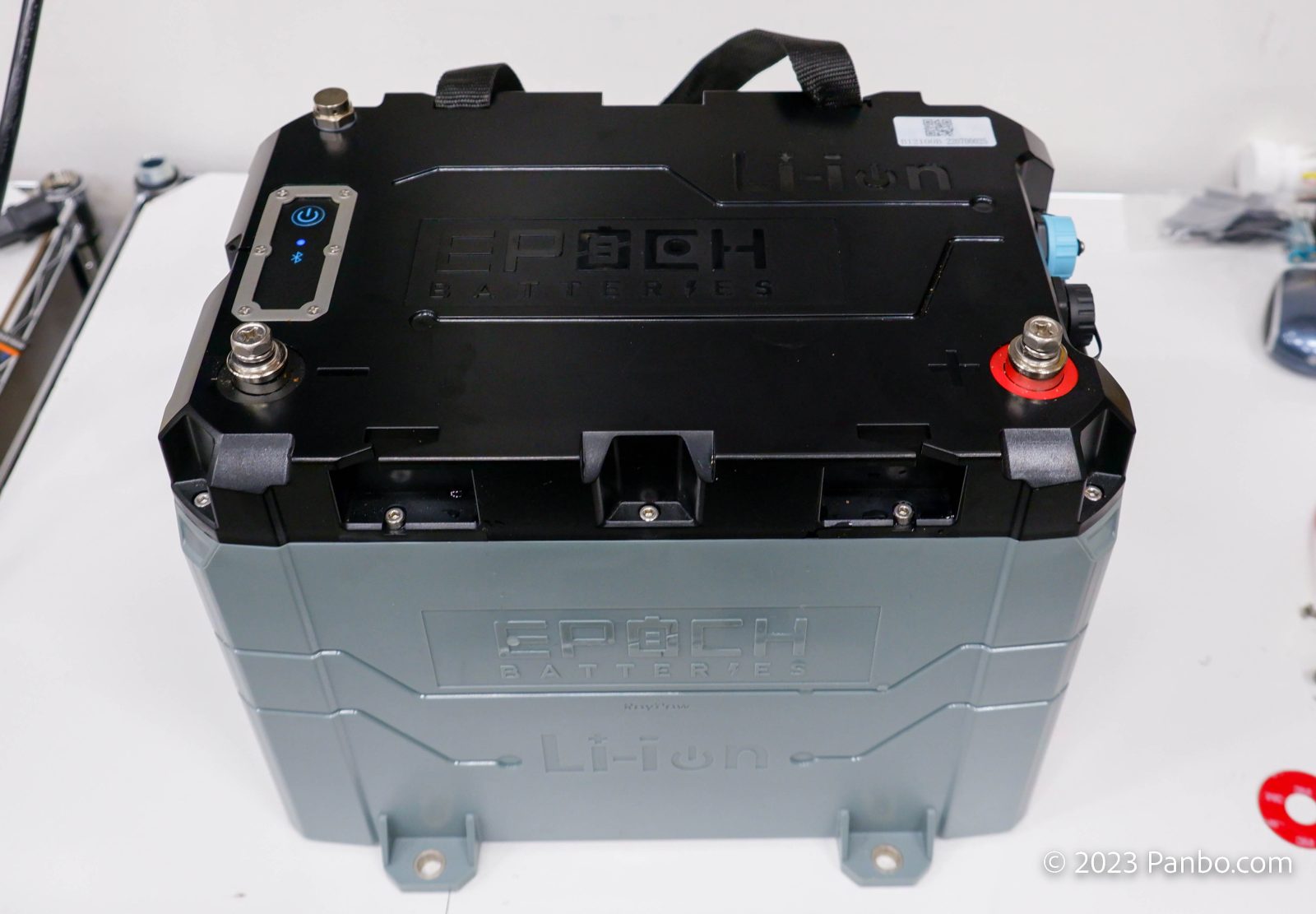
Good design matters, even for a product you probably won’t spend much time admiring. Epoch batteries’ line of LiFePO4 has design covered and an attractive list of features. But the big question is, are these batteries more than just a pretty face? I’ve been putting a couple of their 100 amp-hour, 12-volt batteries to the test, and it sure looks like they have the goods to back up the design.
Epoch Batteries is a division of RoyPow energy. I recently learned Eve, one of the largest manufacturers of LiFePO4 cells, owns RoyPow. BWS – 2/9/2024 I’ve since learned I was wrong. Epoch is owned 18650 Battery Store and the batteries are manufactured for Epcoh by RoyPow. So, it’s safe to say there’s plenty of LiFePO4 experience and expertise available for Epoch to draw on in designing their batteries.
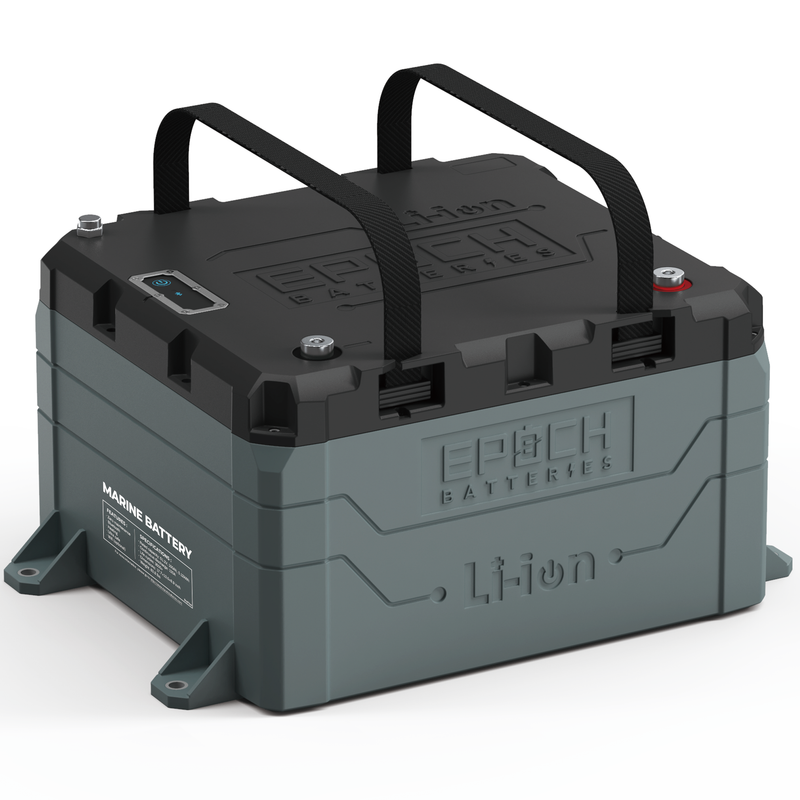
Epoch offers a range of batteries in 12, 24, 36, and 48-volt options. Each voltage is available in 50 or 100-amp-hour capacity. The 12-volt batteries support up to four series and four parallel connections. The remainder of the voltages allow two series and four parallel connections. The four parallel limit for the 100 amp-hour, 12-volt battery may be an issue for larger installations. Epoch says they’re working on higher-capacity batteries. I, for one, would love to see a 400-amp-hour, 12-volt battery in the 48-volt, 100-amp-hour case.
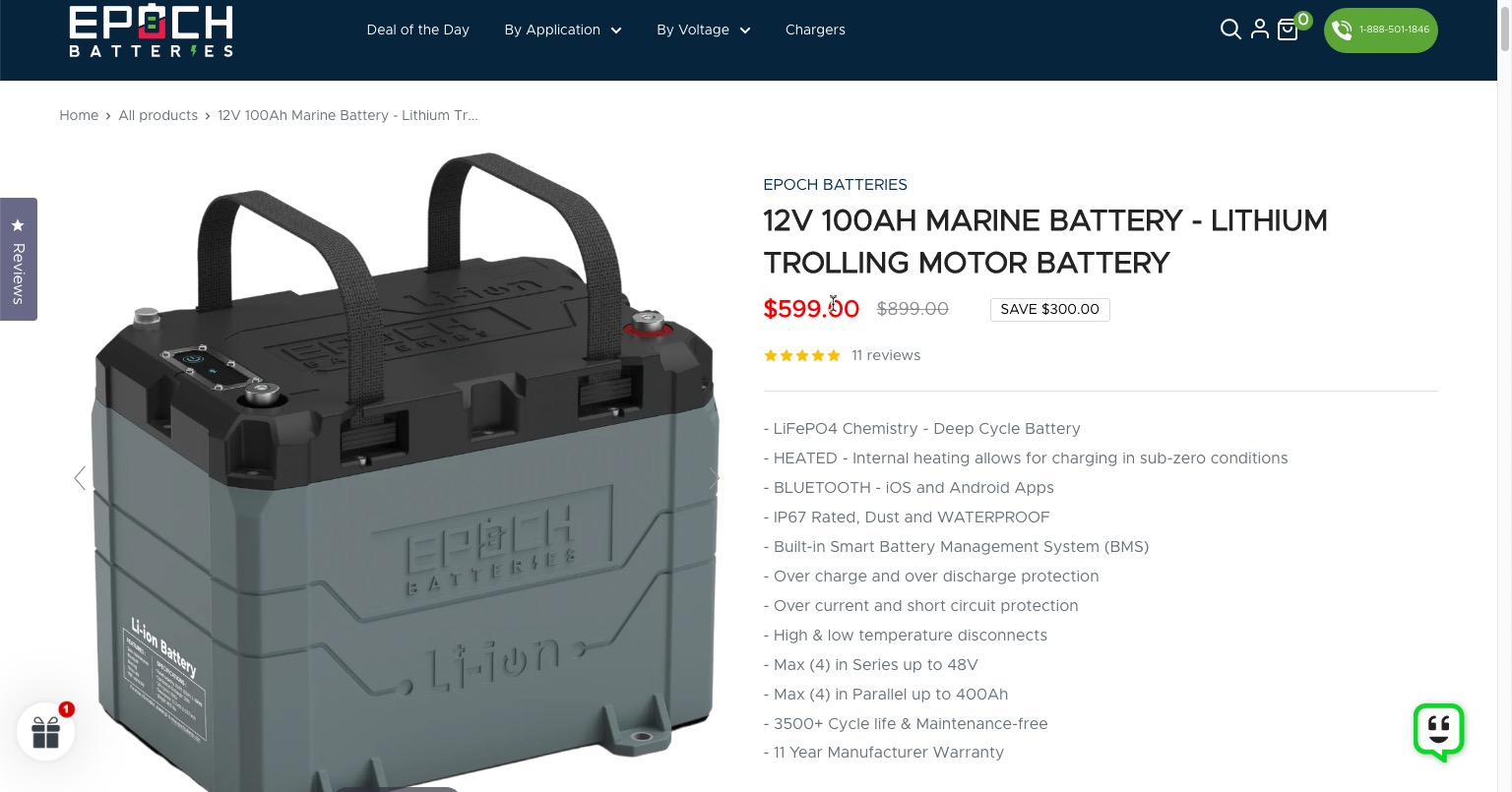
The battery I’m testing currently sells directly from Epoch for $599.00. That makes the battery about $100 cheaper than the similar capacity battery from Kilovault and a few hundred cheaper than one from Battleborn. There are certainly cheaper batteries out there, but I don’t think you will find anywhere near the quality of Epoch’s batteries in those less expensive batteries.
Features
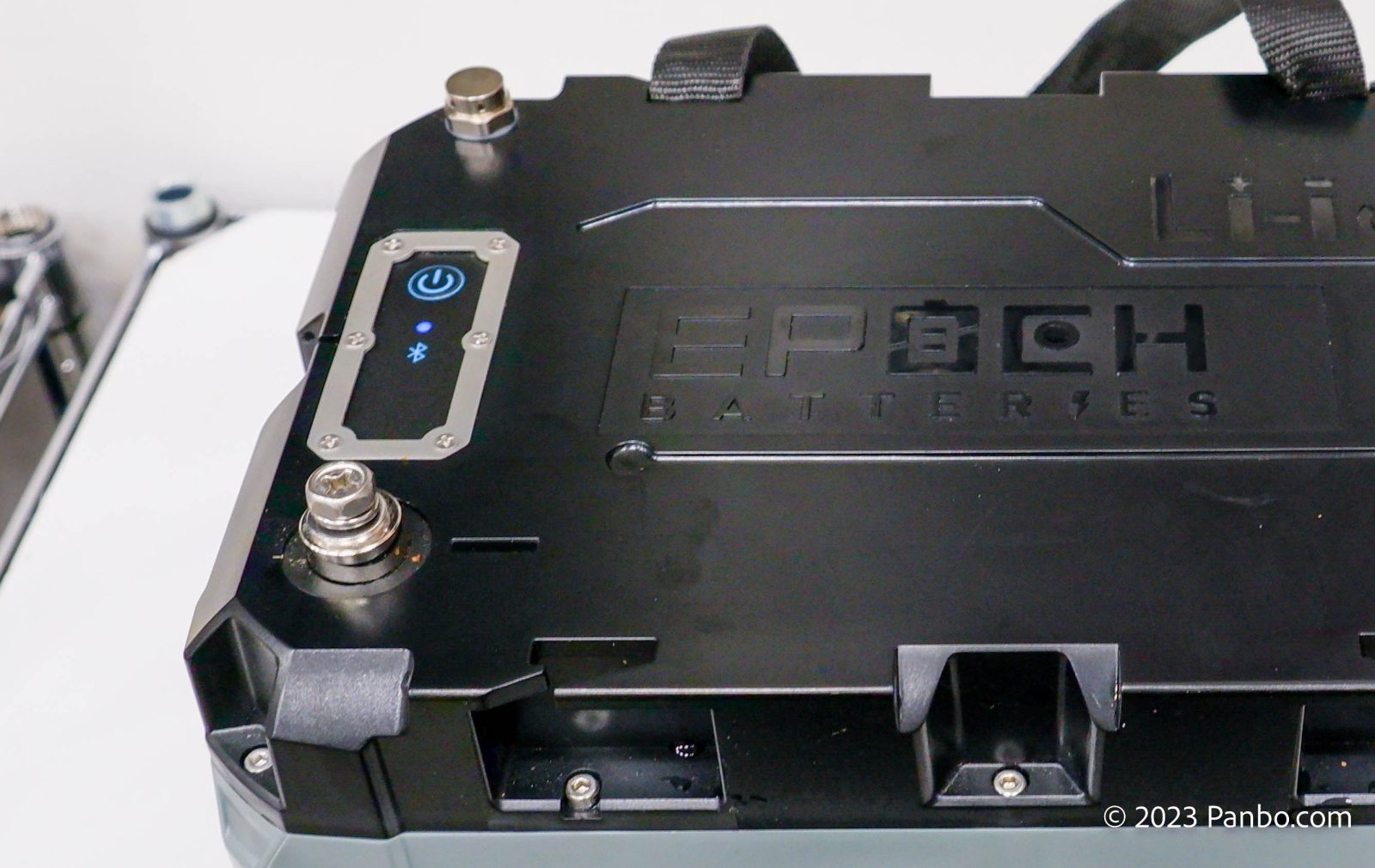
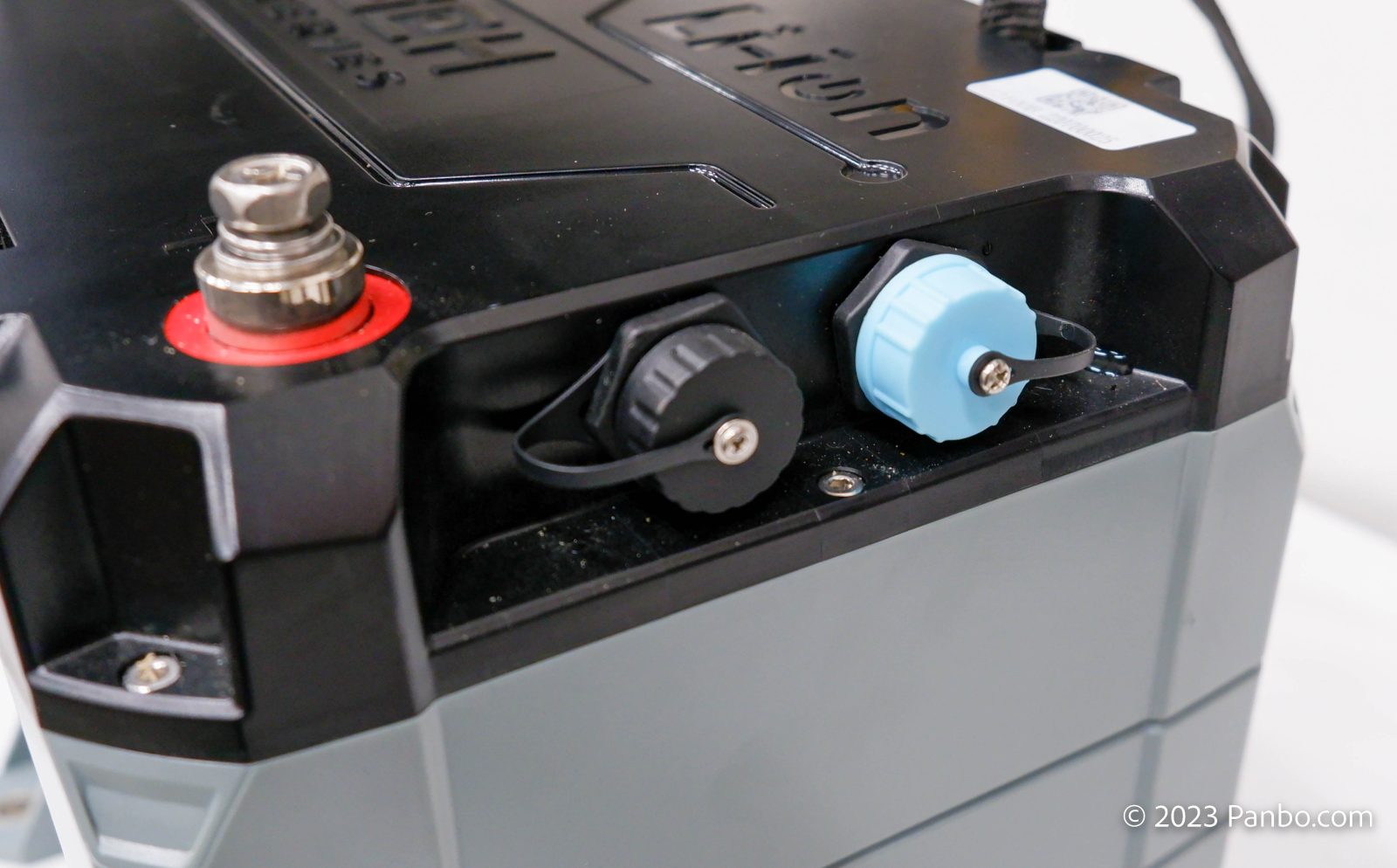
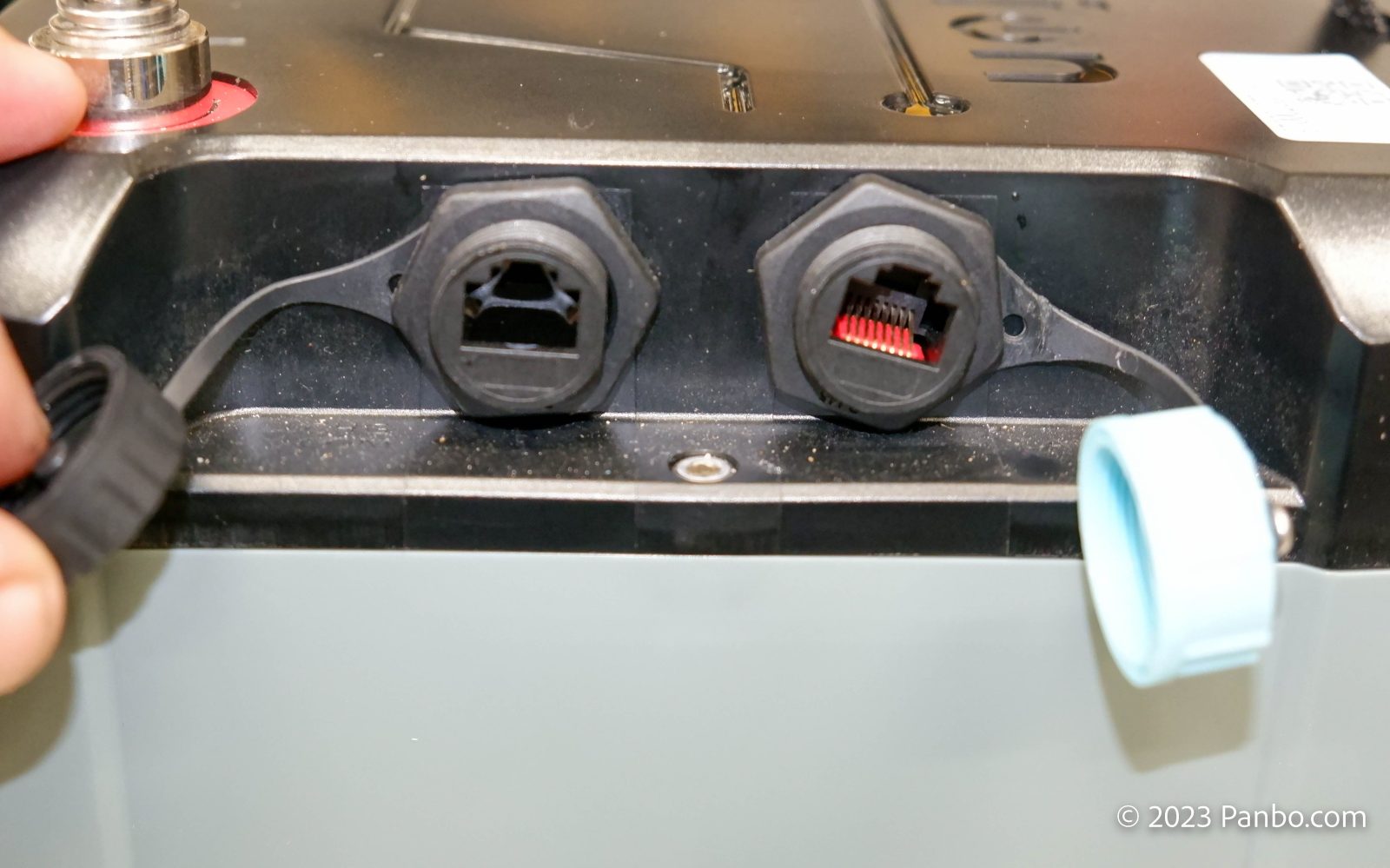
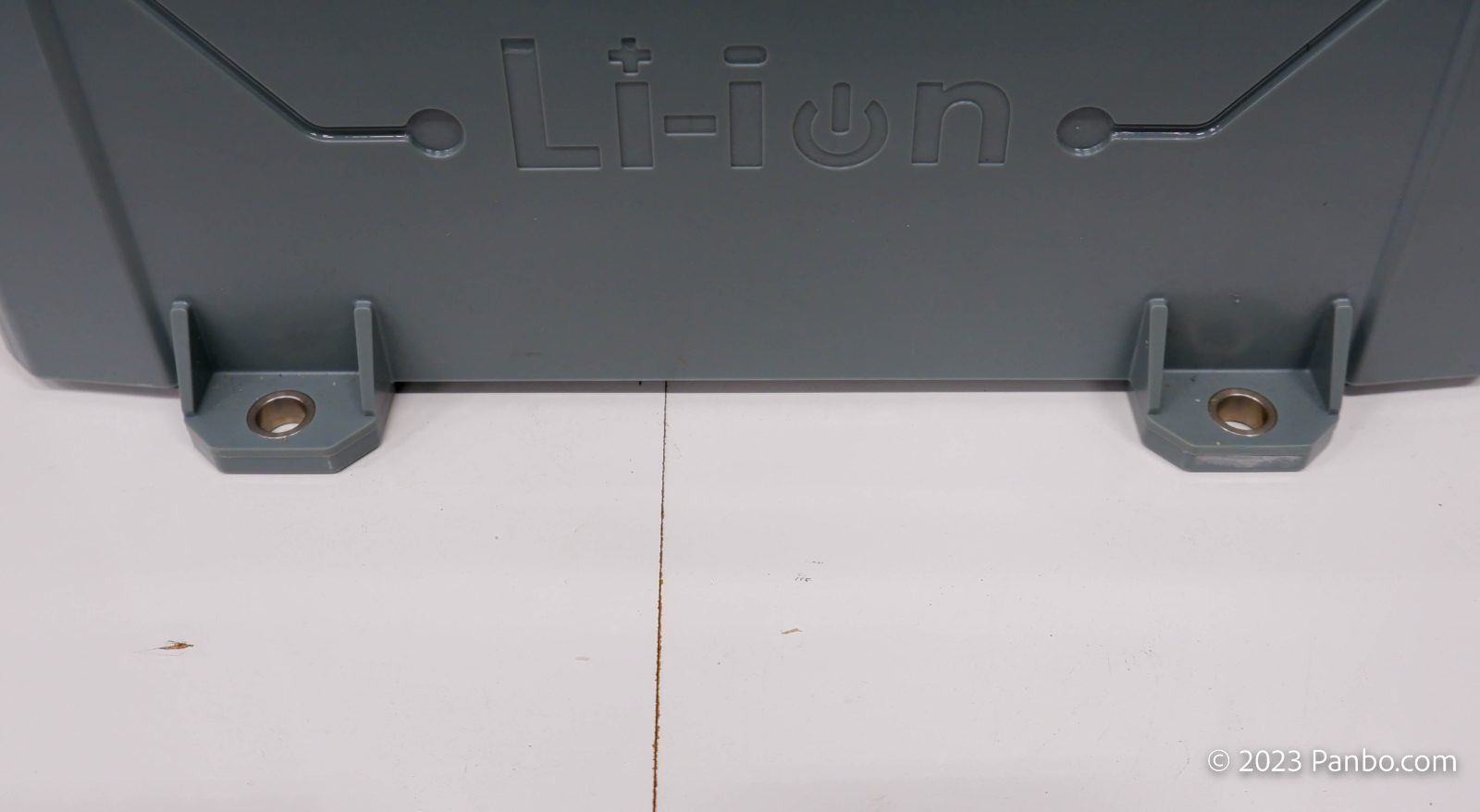
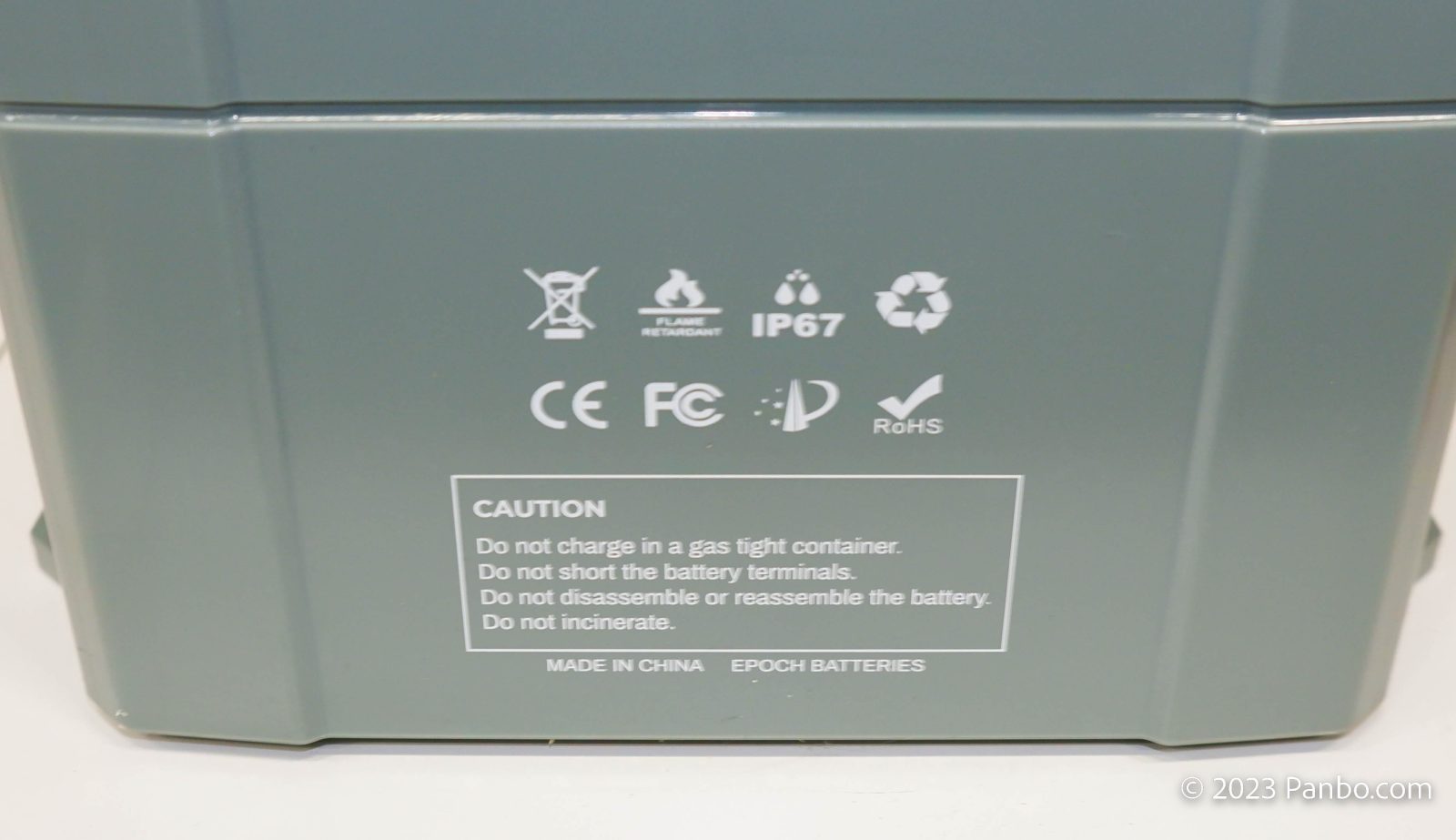
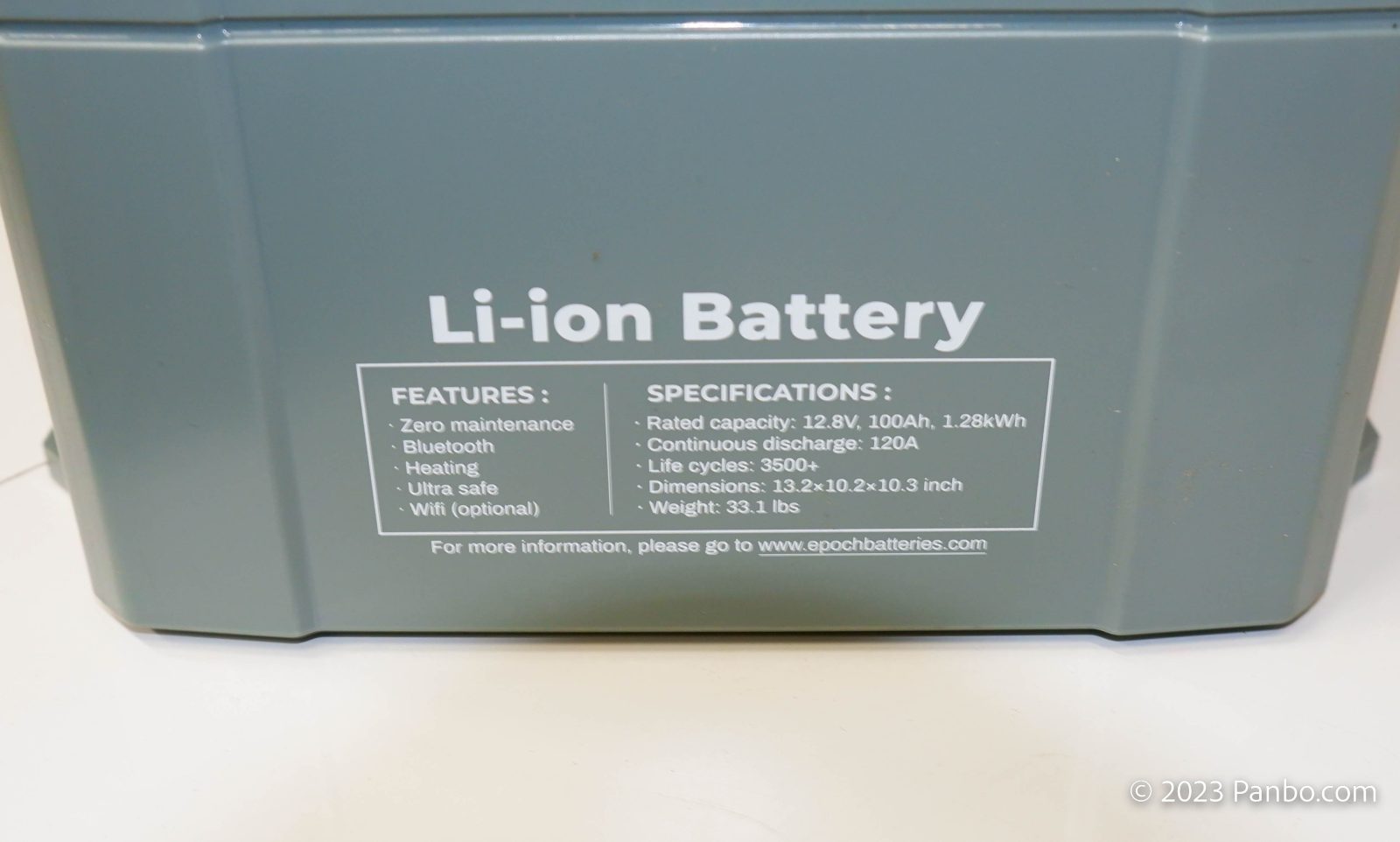
Epoch’s batteries come with a pretty complete range of features. The batteries’ BMS (battery management system) has a Bluetooth radio to easily see the batteries’ status, history, and any warnings or faults. Epoch’s batteries are heated, IP67 certified against dust and liquid ingress, and feature easy mounting feet with screw holes. IP67 means the batteries can be submerged to 1-meter for 30 minutes. Additionally, there is a CANBus external communication port on the side of the battery. The top of the battery includes a pressure relief valve to normalize pressure inside the sealed battery and a power button that puts the battery into a sleep state and wakes it up.
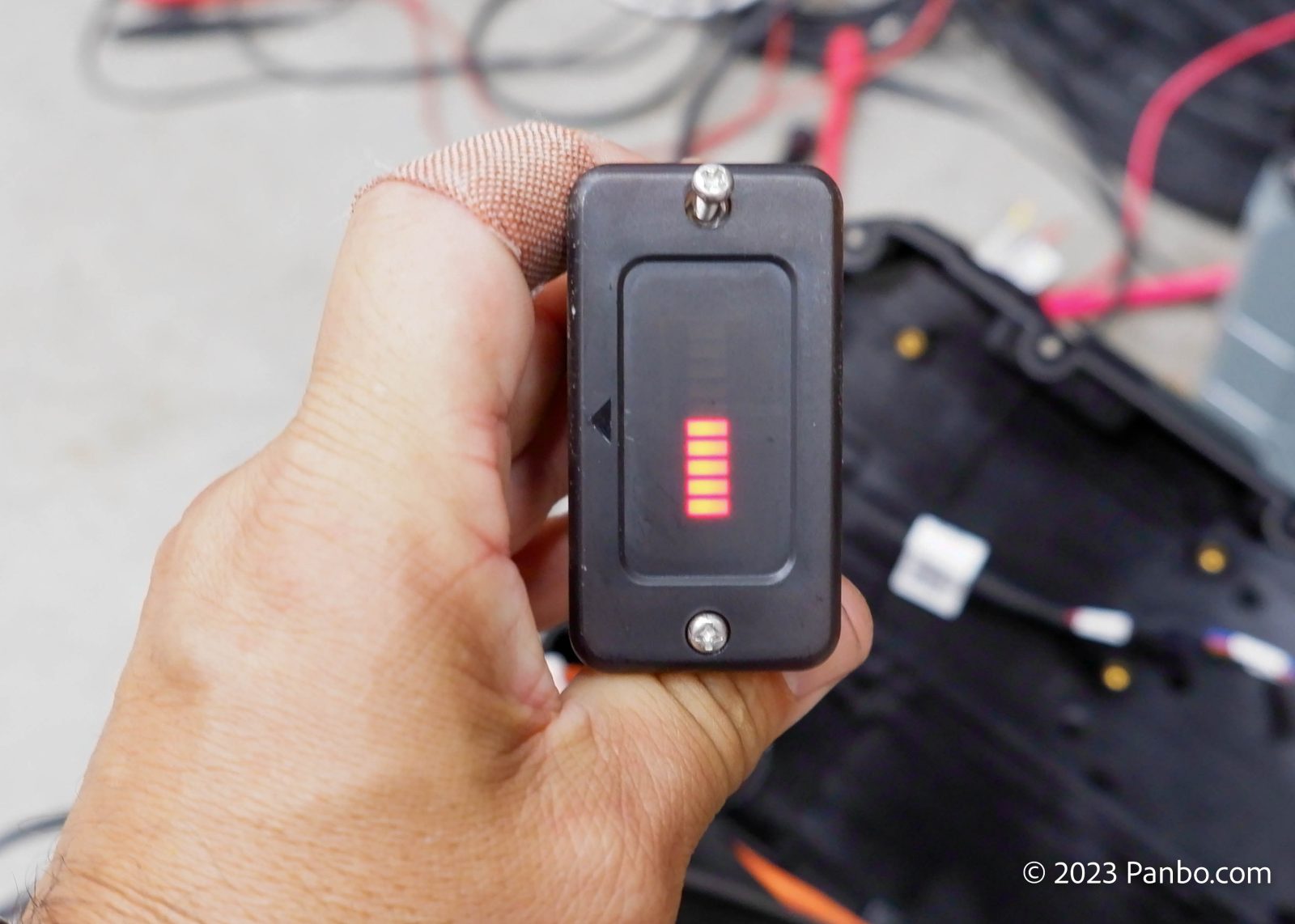
Epoch also includes a 10-segment LED battery gauge that plugs into the communication port and displays battery SOC (state of charge) in 10-percent increments. The gauge connects via the CANBus port, so if you’re using CANBus communications, you won’t be able to use the gauge. I tried connecting a test battery to the VE.Can port on a Victron GX system and wasn’t able to establish any communications between the battery’s BMS and the Victron system. Epoch reports they’re working on testing communications but didn’t have any information to provide yet.
Performance
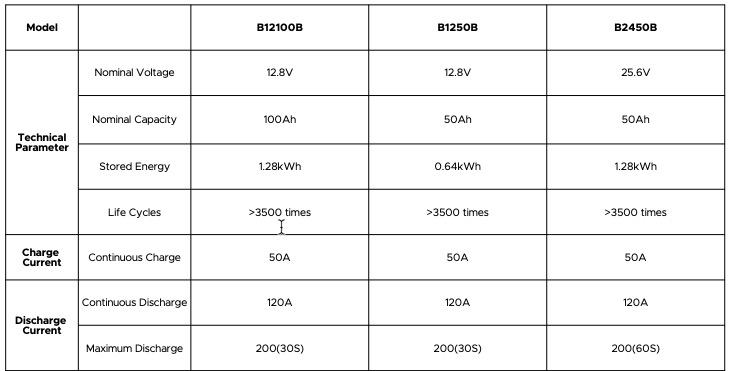
The 12-volt, 100-amp-hour battery I’m testing is rated for 120 amp continuous discharge and 50 amp continuous charging. During my testing, I widely exceeded these values and eventually saw the BMS’ protection kick in, but not until I’d blown past those ratings by large margins.

Although my 12-volt battery is advertised with a 100-amp-hour capacity, it contains four 105-amp-hour cells in series. So, the actual capacity of the unit is 105 amp hours, as I’ve been able to confirm in multiple rundown tests. In fact, as the picture above shows, a 20-hour rundown test performed at 5-amps yielded just shy of 110 amp hours. Consider that many lead-acid batteries fail to meet their rated capacity, even when brand new. That makes these batteries, including a bonus 10-percent capacity, sound pretty darn good.

Consistent with the behavior we typically see with LiFePO4 batteries, these batteries show a very flat voltage discharge curve. The graph above shows the results of a 20-hour rundown test performed at five amps. That’s the 20-hour discharge rate for these batteries and we can see the typical nearly flat voltage line until we reach near zero-percent SOC. In fact, at just five-percent SOC, the battery still provided 12.6 volts.
Massive load handling

That stable voltage (and impressive load handling) continues as the loads increase. In the case of the chart above, the loads have gone way up. I’m using a 2,000VA inverter and a heat gun to generate over 150 amps of load. Consider that’s a more than 1.5C (1.5 times the battery’s rated capacity) load. If allowed to continue, the battery fully discharges in under 40 minutes.
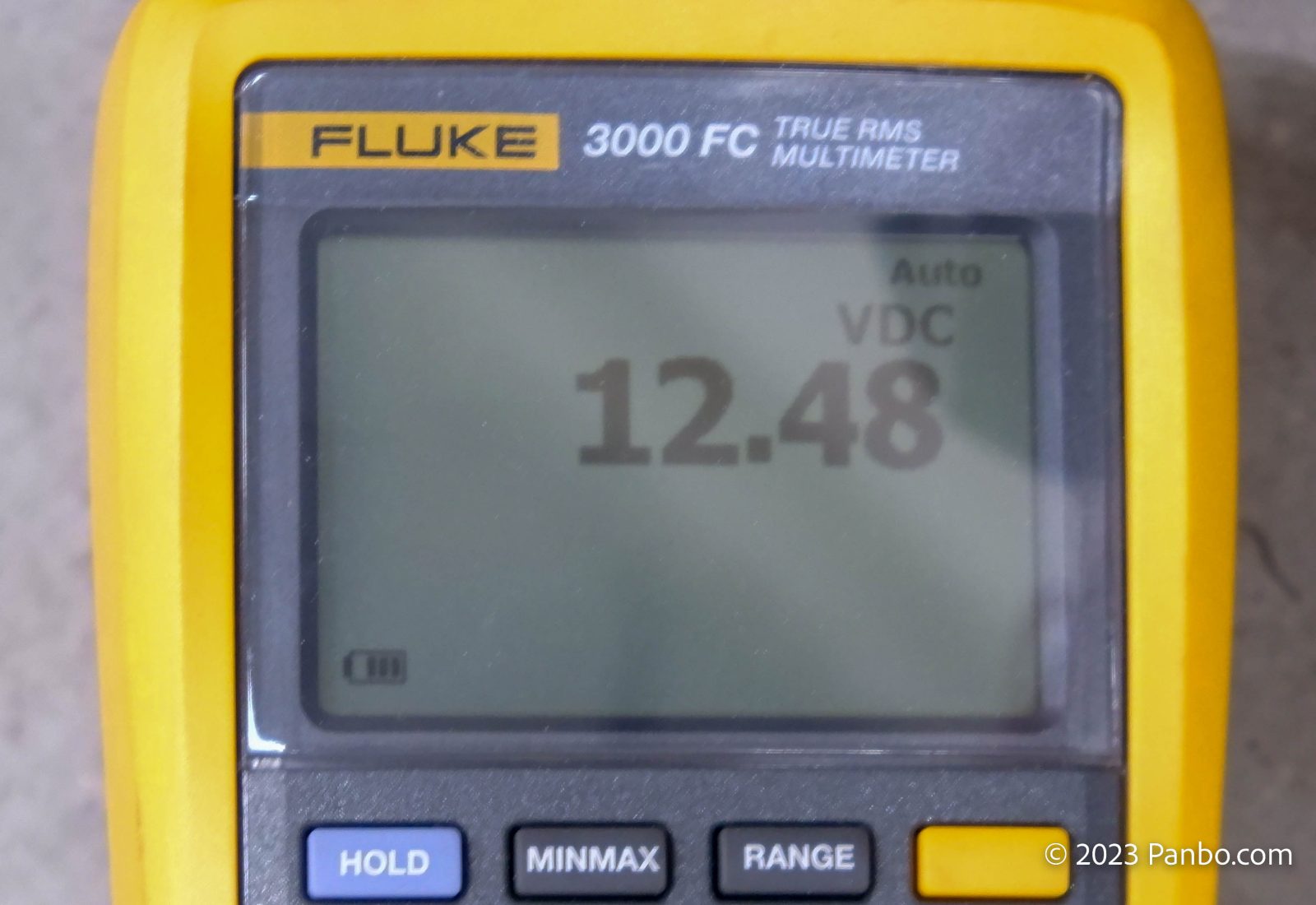
You may have noticed that the voltage shown in the VRM graph above is pretty low, at about 11.5 volts. That’s a limitation of how I’d set up my test bench. I have the voltage probe of the SmartShunt on the bus bar rather than directly connected to the battery. The result is the SmartShunt sees the voltage drop across the wiring of my test bench from the 150+ amp load. The shot of my meter above shows the voltage at the battery terminals. Maintaining 12.5 volts under a 150 amp load is an impressive performance for a single battery, well over its ratings.
The app
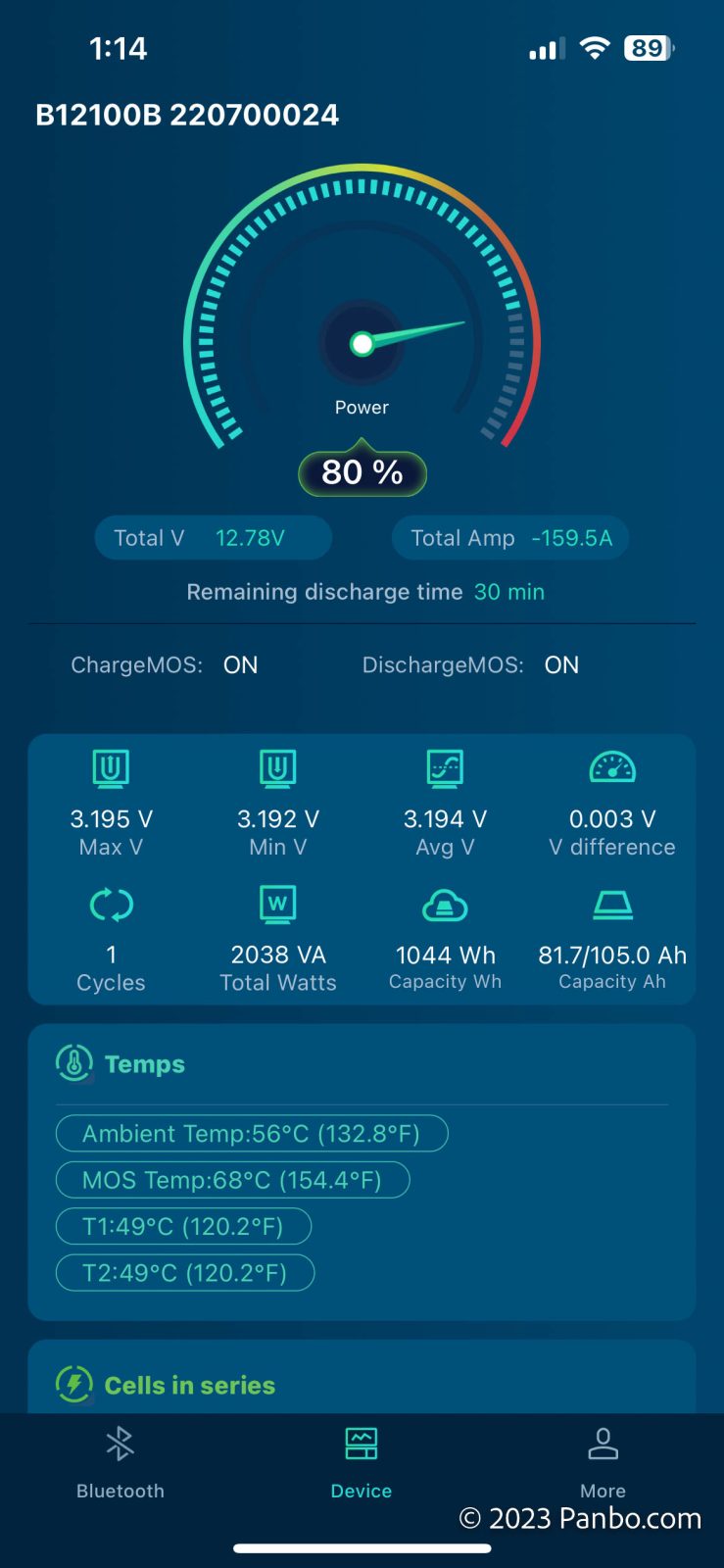
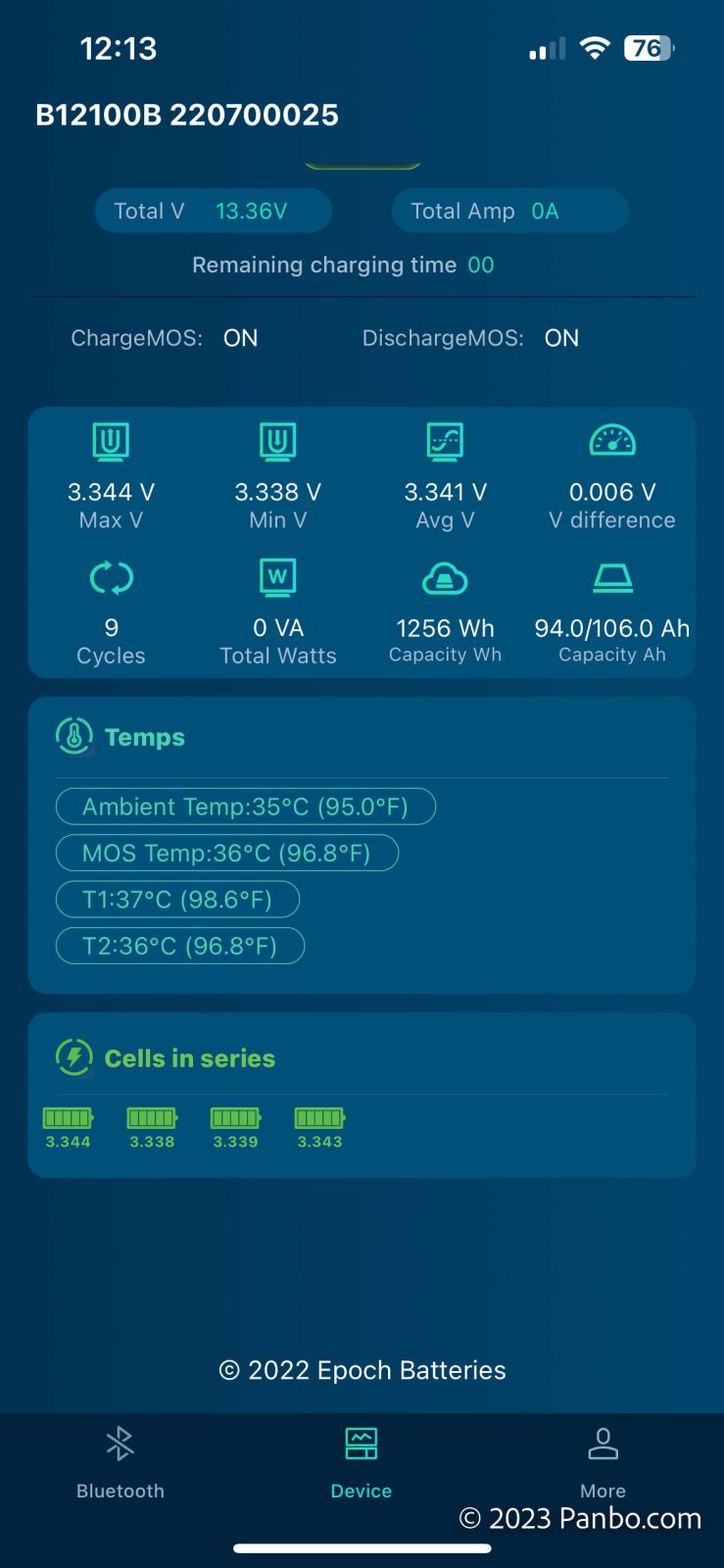

In my review of the KiloVault HLX+ batteries, I liked nearly everything about the batteries, until I got to the app. I felt it left a lot to be desired and seemed like an afterthought. Not so with Epoch’s app. The app is attractive and functional. It also gives a lot of insight into the battery’s operations.
At a glance, one of my favorite pieces of information is the cell voltage difference or cell delta. Cell delta, especially over various states of charge and at differing loads, gives you insight into how well they matched the individual cells. The results from my testing indicate an excellent cell match. In fact, I don’t think I’ve seen more than 0.015 volts difference at any time.
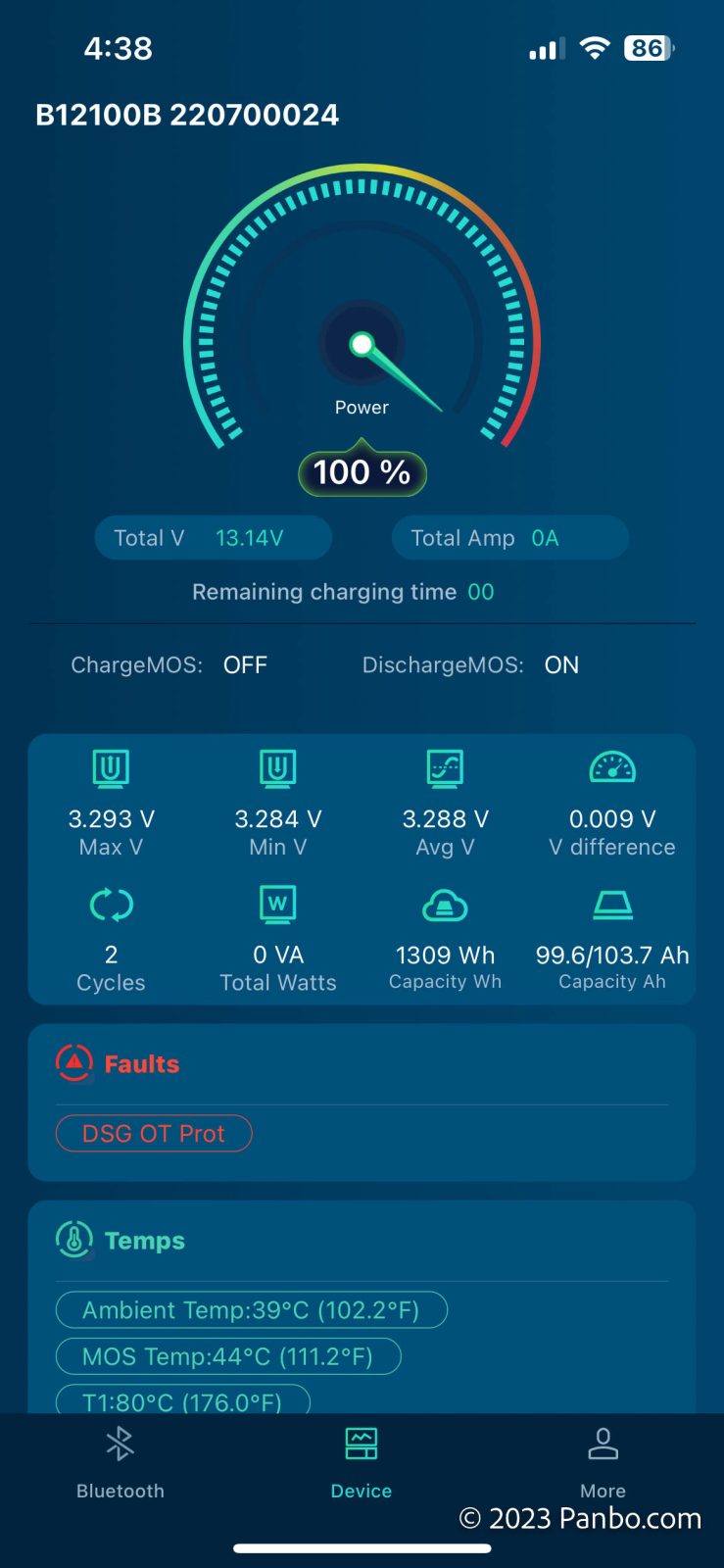
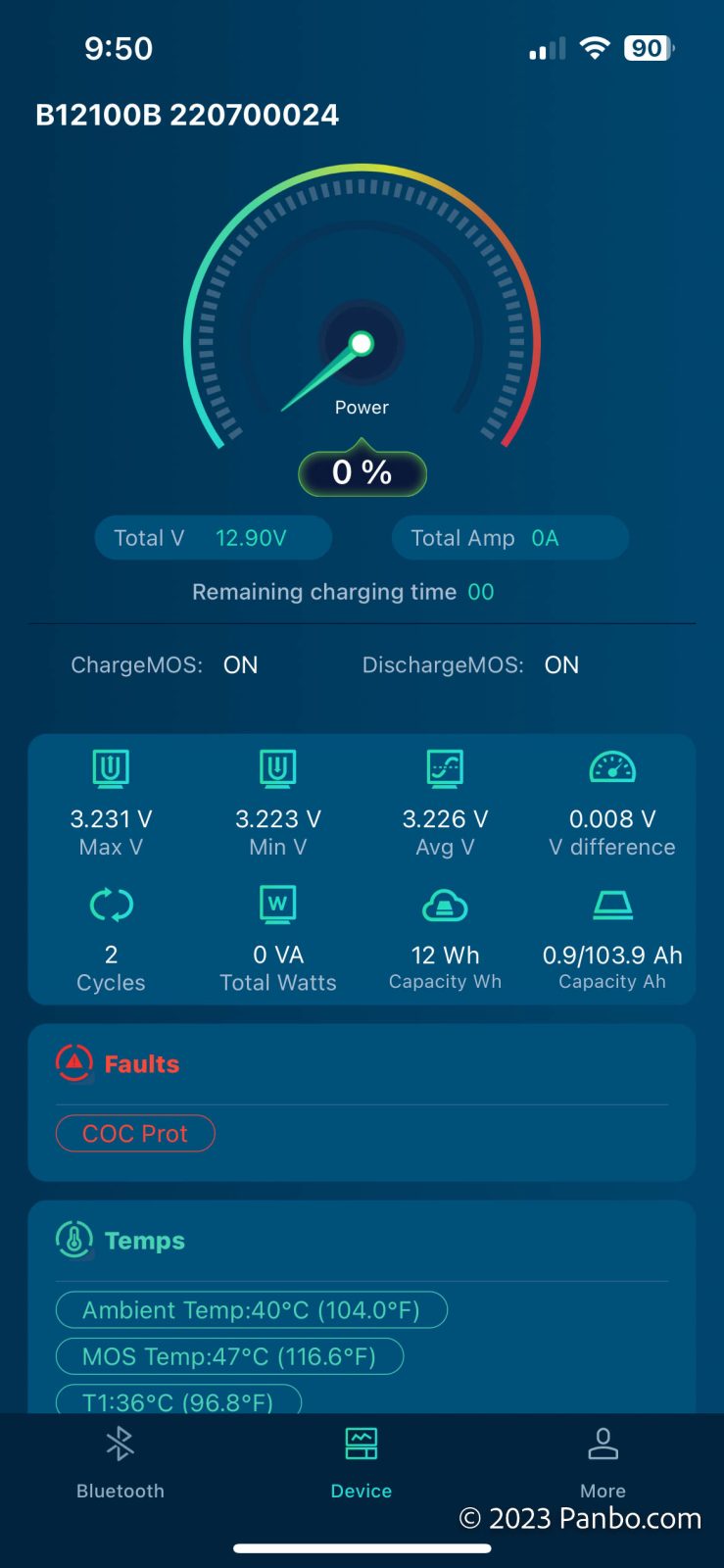
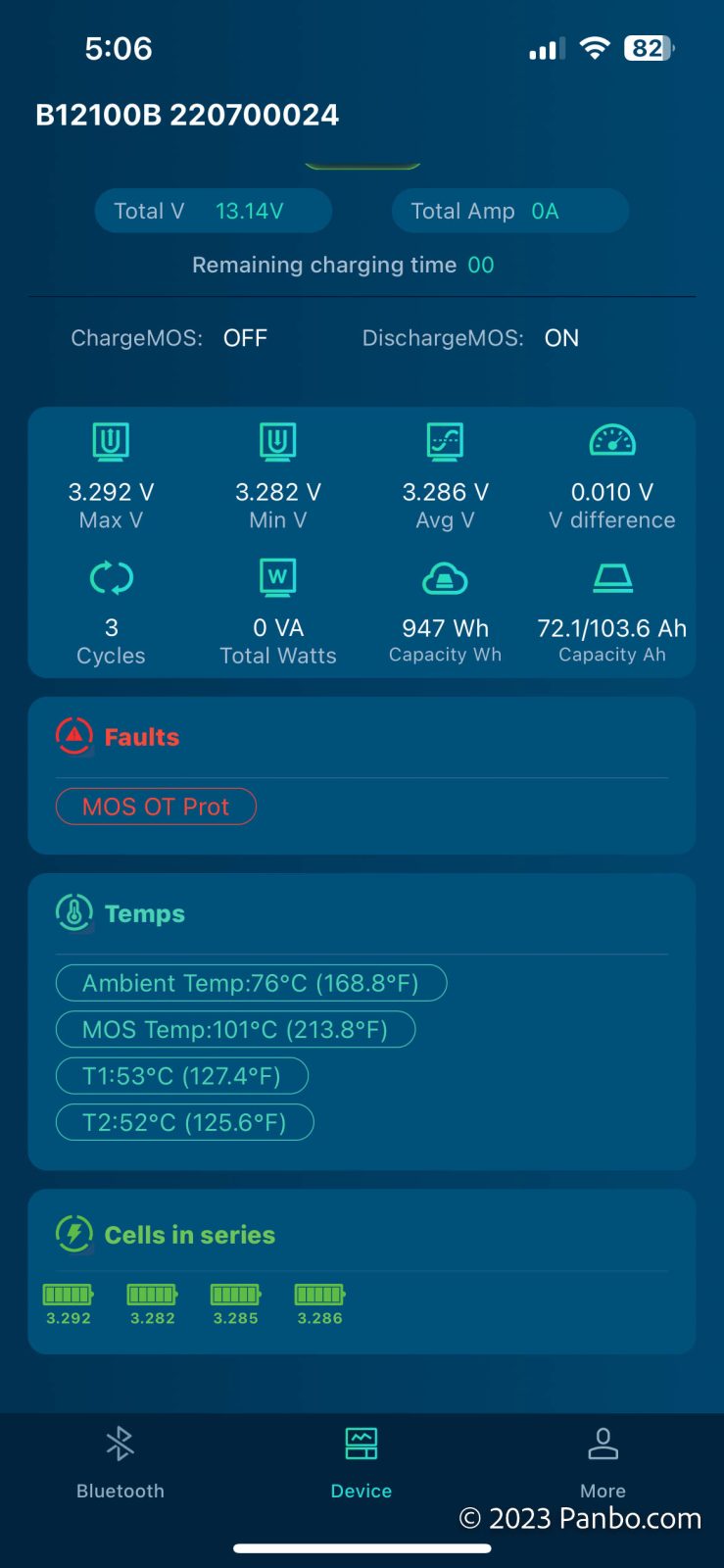

Fault display is a weakness of the app. The faults are displayed without any information about the fault and often in difficult-to-decipher acronyms. Fortunately, the fix is pretty easy. Decoding acronyms and making the faults clickable to display more contextual information would be a nice improvement. I noticed another oddity: the battery app displays a fully charged fault when the battery reaches 100 percent SOC.
The app did show behavior I haven’t seen before from a drop-in battery. The last screenshot above shows a fully charged “fault.” In addition to showing the fully charged condition as a fault, the battery stops accepting charge when fully charged. Unfortunately, that’s not reflected by the charge and discharge MOS status indications. In fact, I never saw those change during my tests.
Tear down
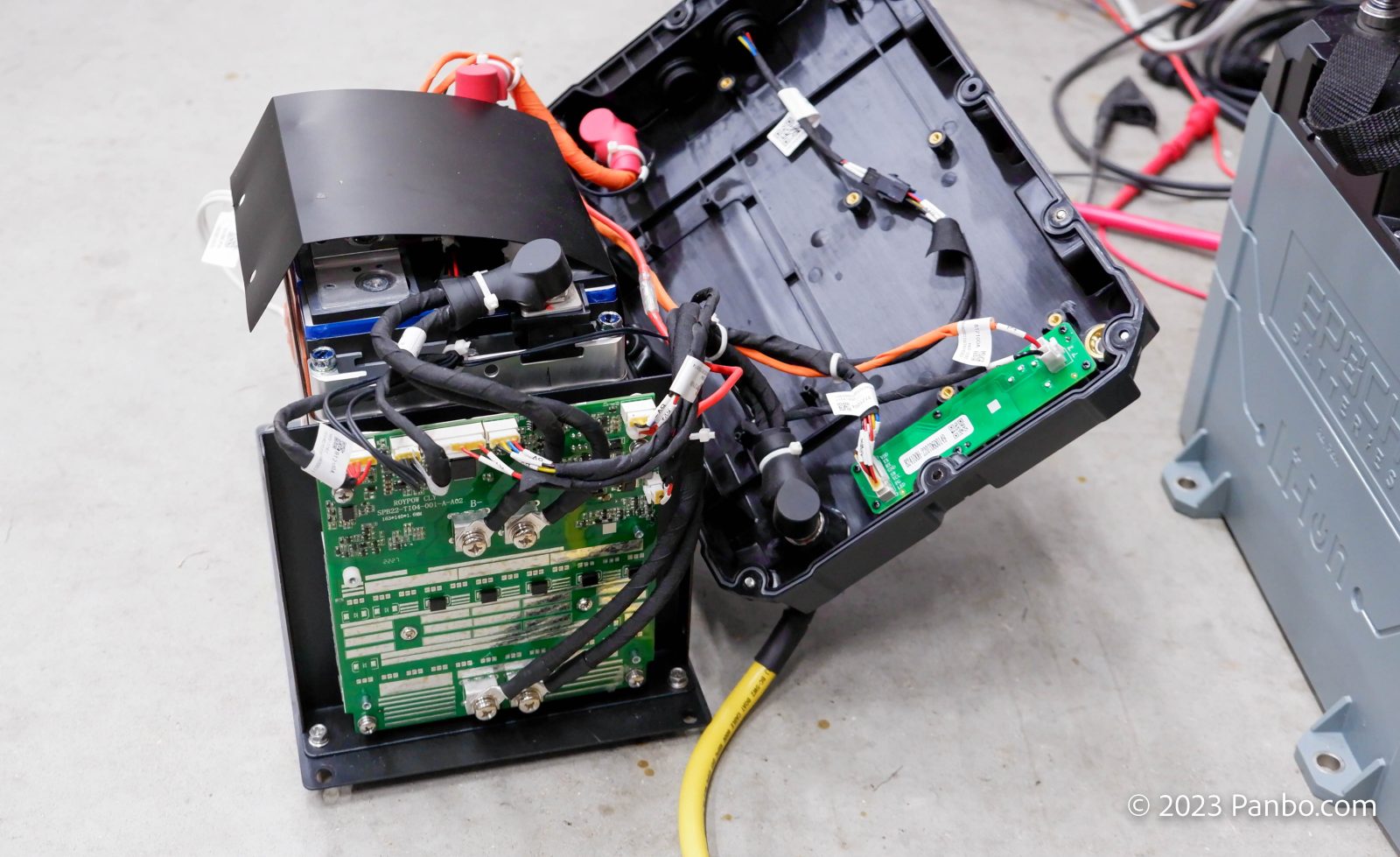
Tearing down an Epoch battery only requires removing the 12 hex-head screws from the top of the case. With those screws removed, the case and top easily separate. The top has a rubber gasket that seals the battery from dust and water.
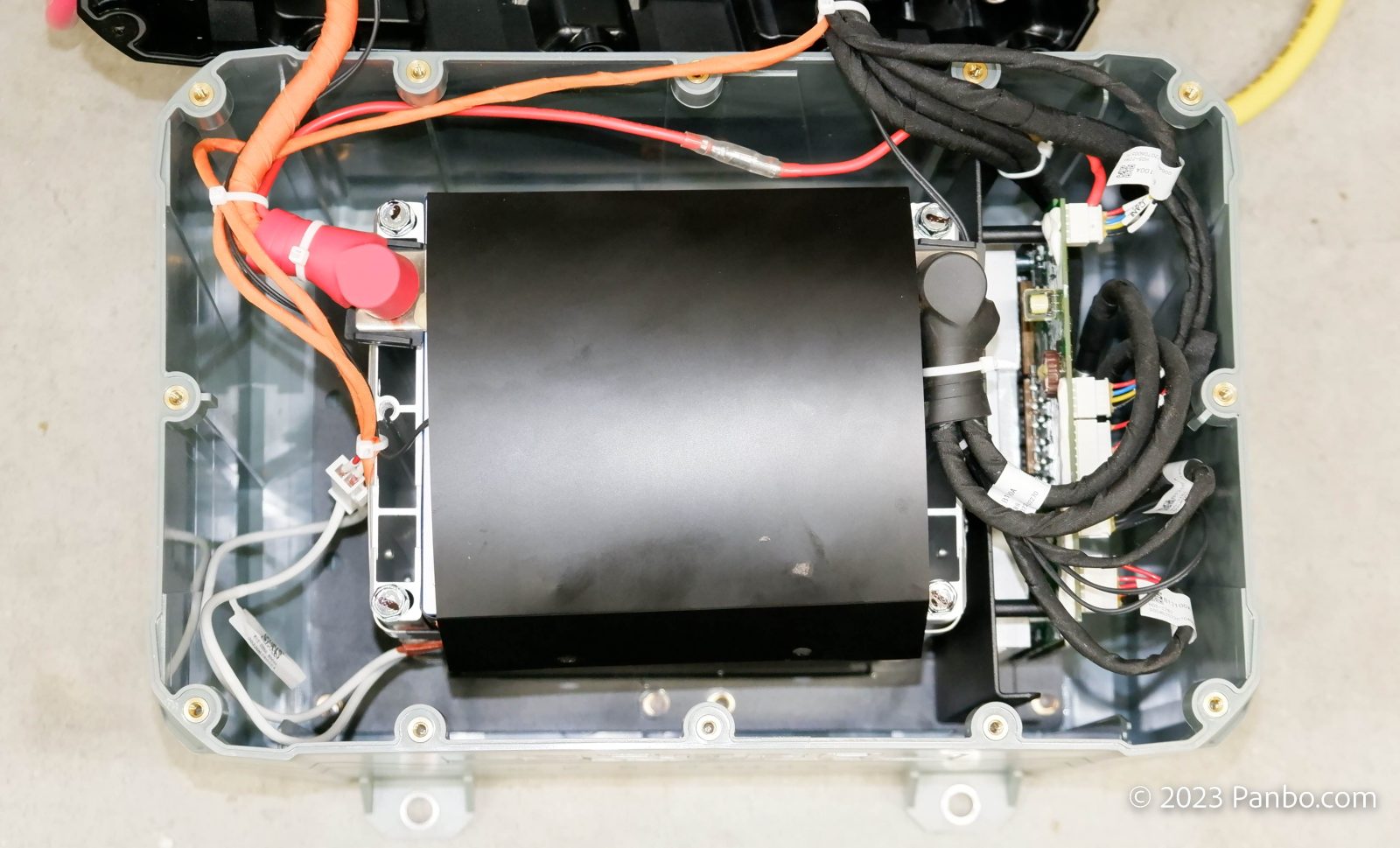
Upon unboxing the batteries, one of my first observations was that the case was larger than I expected for a 100-amp-hour battery. Removing the top shows there’s quite a bit of extra room around the battery. I’m not sure if there’s enough room to pack double the capacity in there, but I think something like 160 amp-hour cells would likely fit.
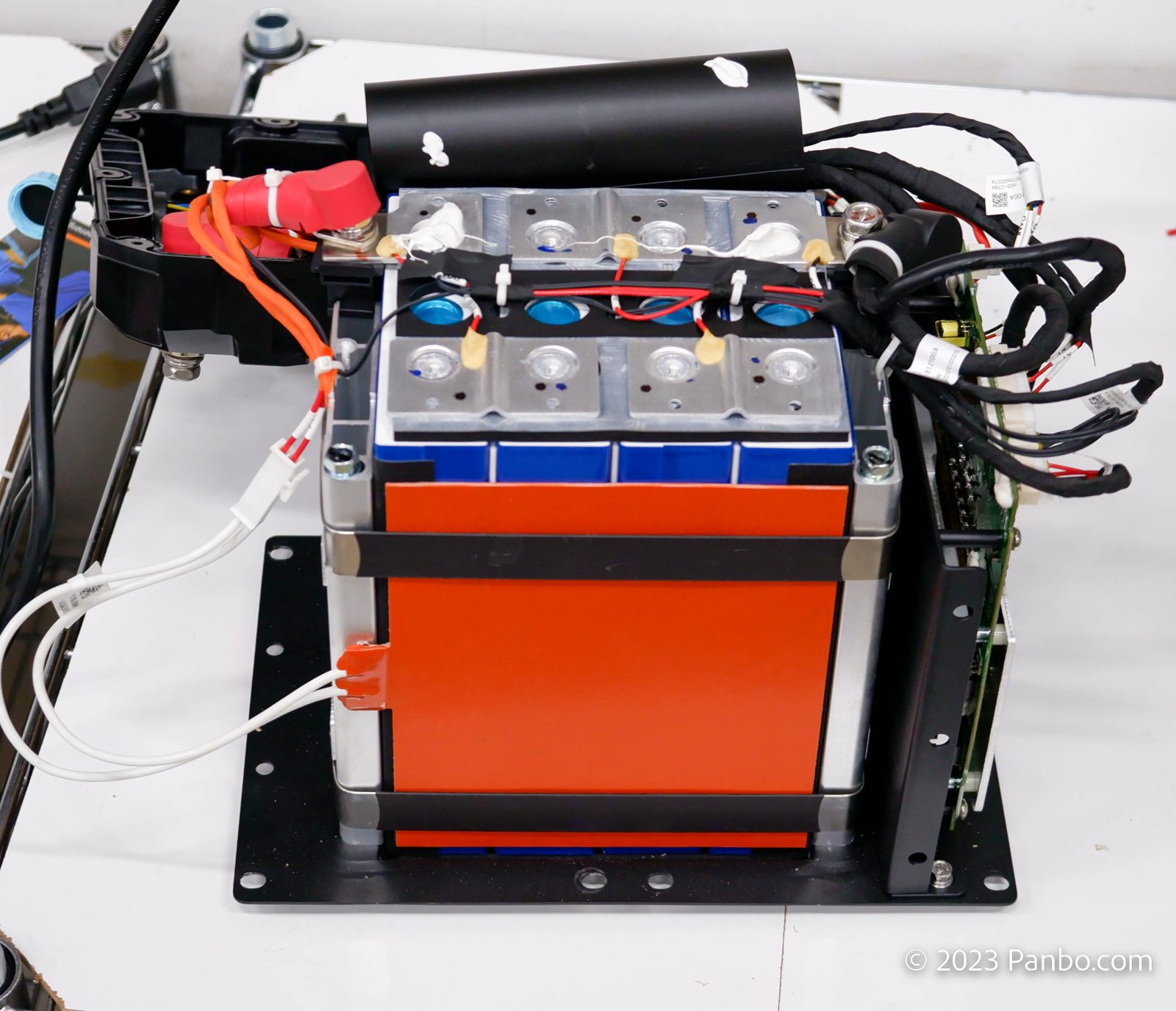
Aside from the extra space, I also noticed high-quality construction and impressive battery serviceability. The cells and BMS mount on a tray screwed to the case. With those screws removed, the tray removes and the battery is easily seen and explored.
I’ve disassembled several batteries, and so far, I haven’t encountered one that gives me pause. But I also haven’t encountered one put together this well. Nearly everything about the battery is top-notch and exceeded my expectations. I will detail several of the high-quality features I noticed, though I may not be able to capture all of the features.
Cell compression
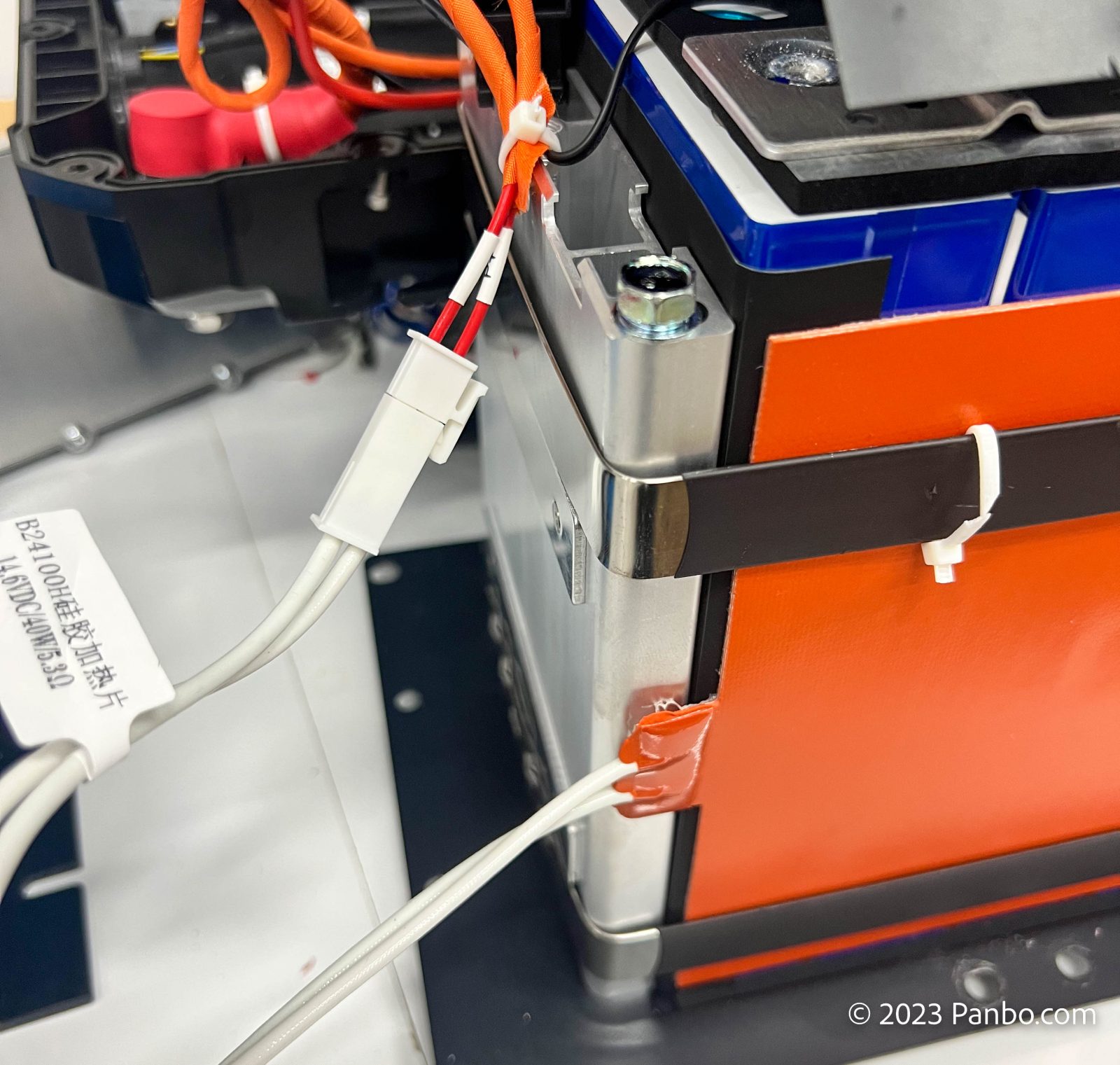
Compressing cells keeps them from swelling under charge. Not too many batteries I’ve seen have robust cell compression. This may or may not be a problem, depending on the charge rate the battery experiences. But, allowing cells to swell during charging will damage them. That damage may result in reduced performance or even premature failure of the cells. Current Connected has a good explanation of cell compression. Epoch uses large aluminum braces on each end of the pack with robust strapping holding compression on the cells.
Temperature sensors
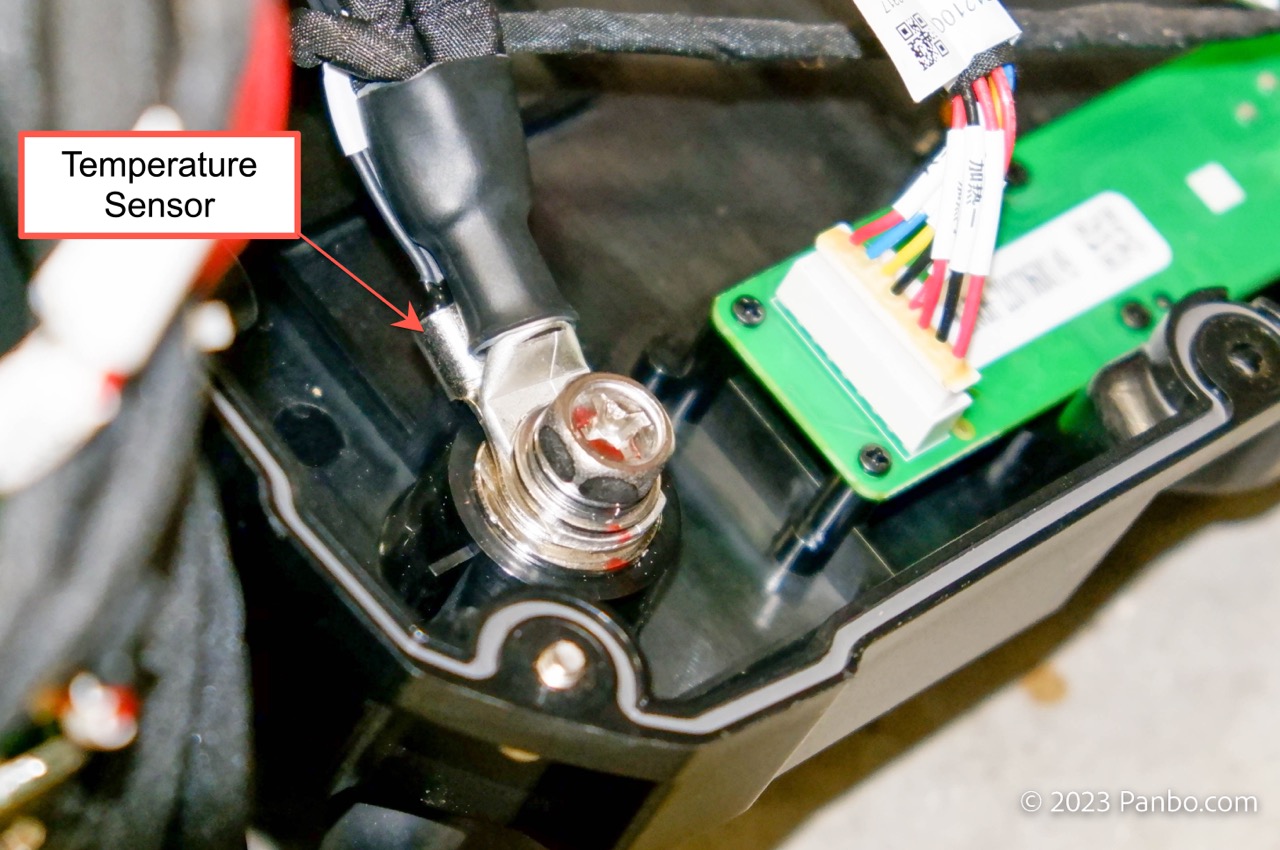
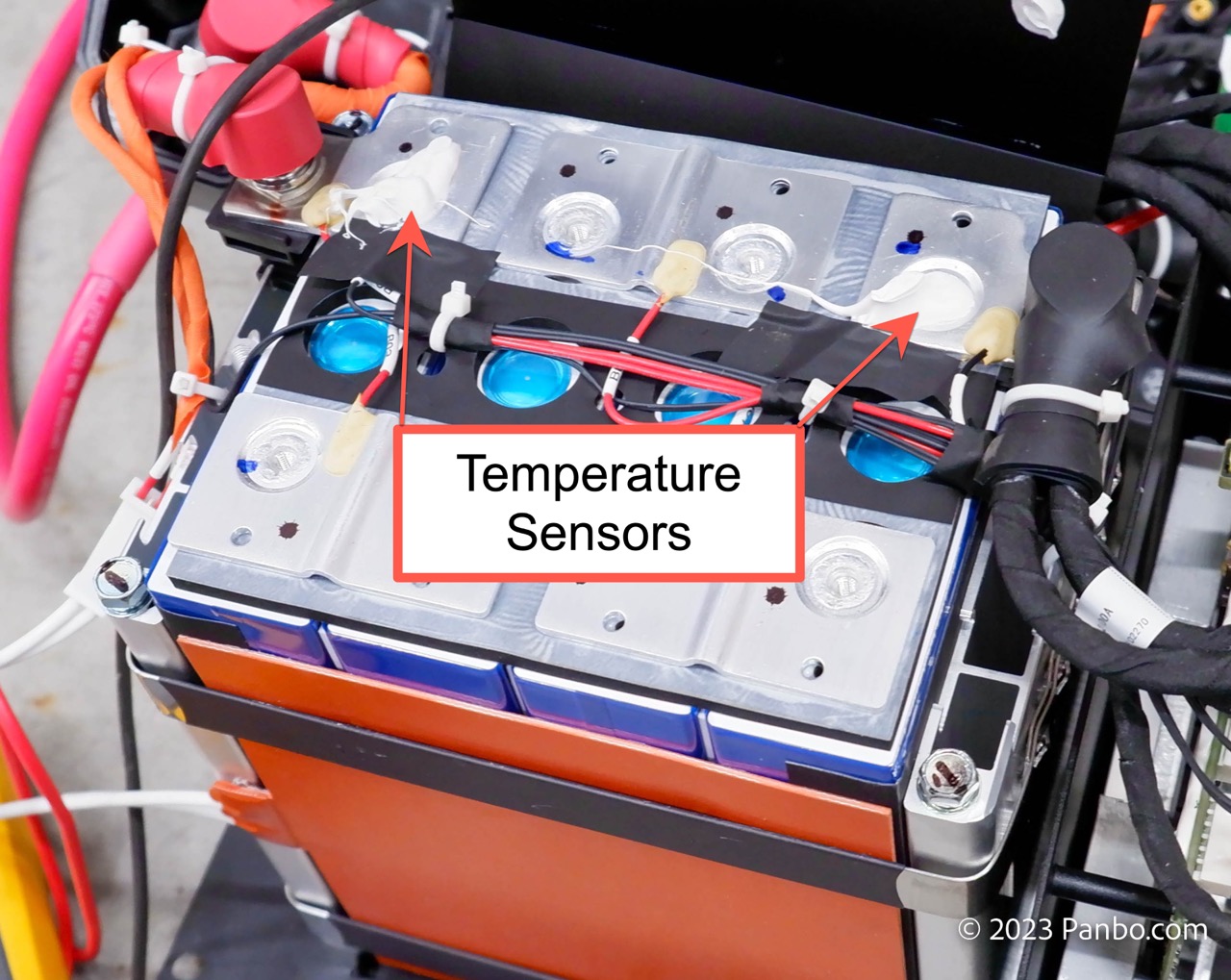
Each Epoch battery contains six temperature sensors: two on top of the battery pack, one on the underside of the positive and negative posts, one on the BMS’ FETs, and one to measure ambient temperature. The sensors under the terminals are especially useful as they will shut the battery down if a poor connection produces too much heat. Without those sensors, that poor connection can easily generate enough heat to damage the battery, if not cause a fire. Interestingly, the app only displays four of the temperature values. The terminal sensor values don’t display in the app. Additionally, I heated a terminal hot enough for the BMS to shut down discharge current, but that fault also didn’t show in the app.
Labeling and insulation
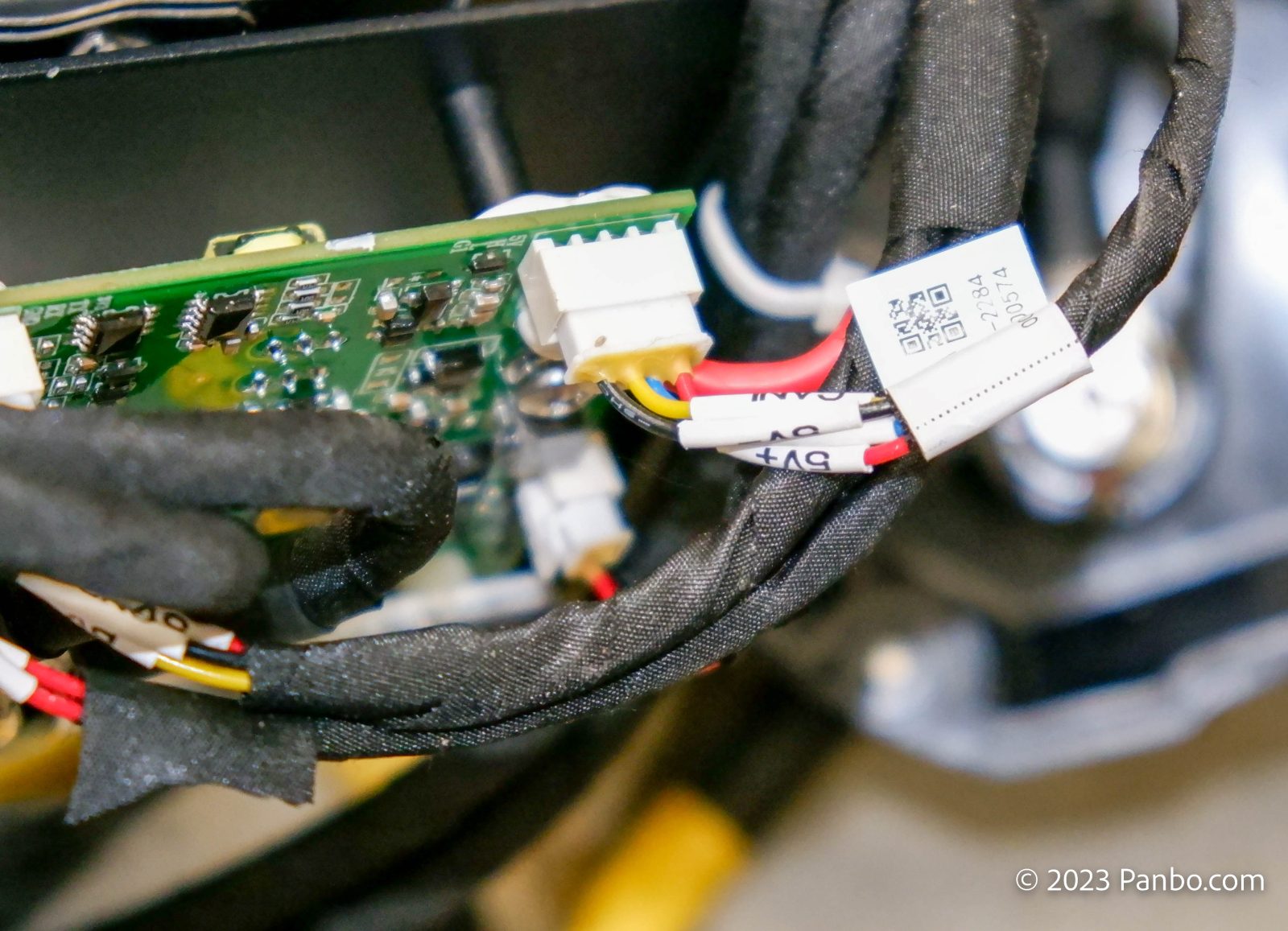
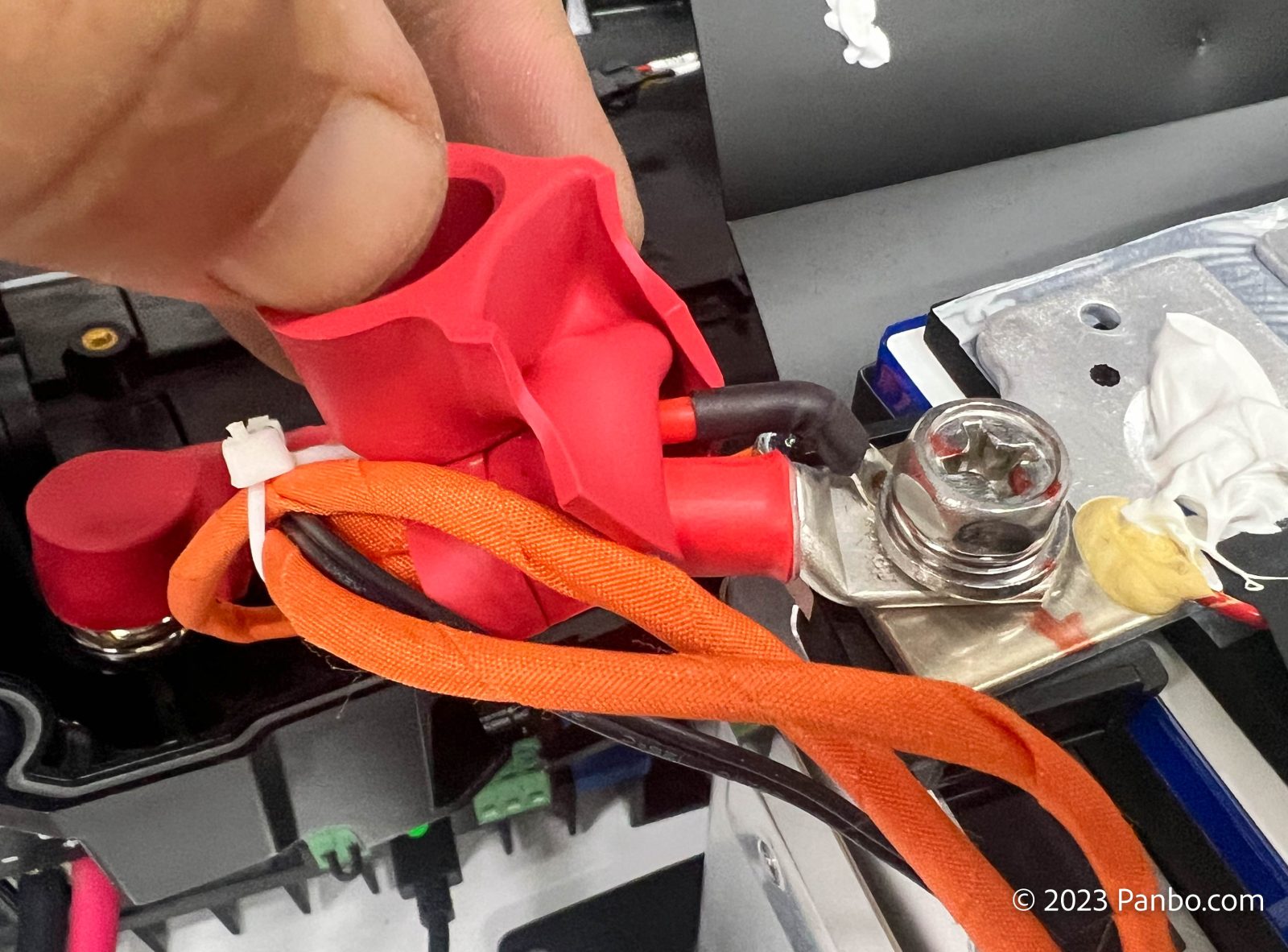
In another indication of the care taken with engineering and construction, each wire and connection is clearly labeled and all the wires are carefully insulated and protected. Wire protection extends to heat-resistant, color-coded, fabric tape applied outside the current carrying conductors. Those conductors use 200-degree celsius insulation and are all doubled-up 8 AWG wires.
Heat management
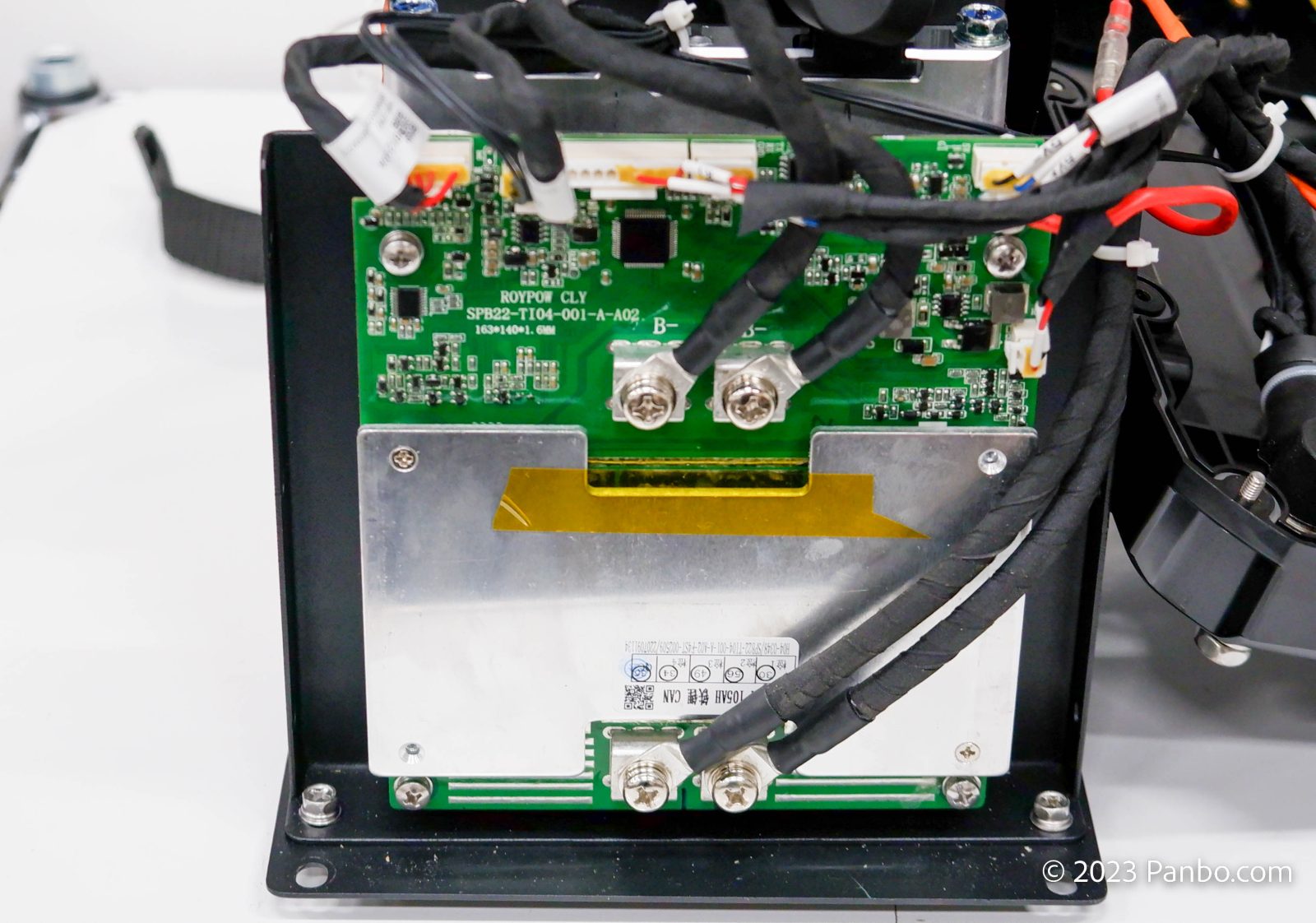
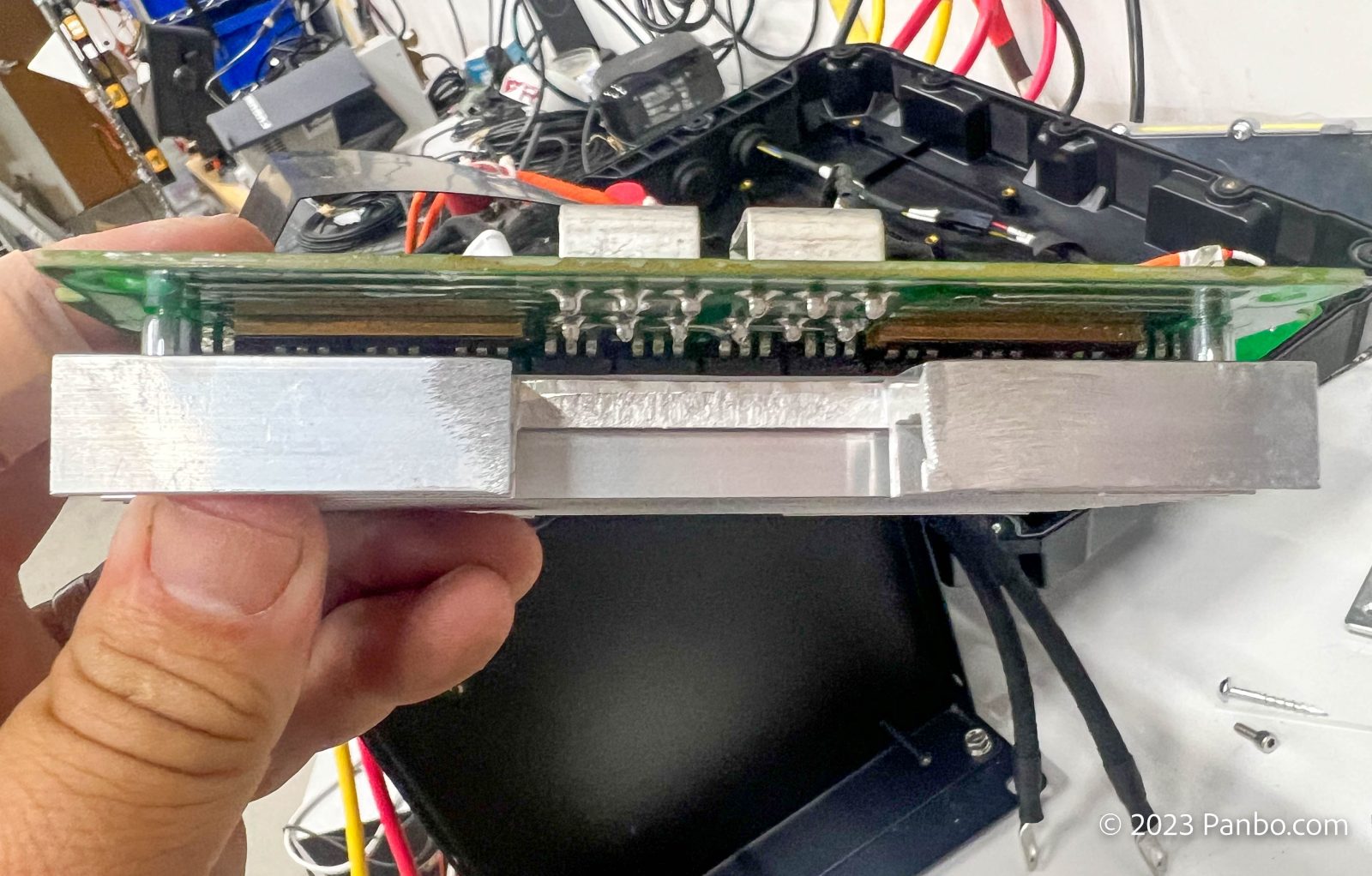
The BMS on my 100 amp-hour, 12-volt test battery carries a 120 amp discharge rating. To manage the heat generated by that relatively high discharge, the BMS has a standard heat sink on the front covering the area of the BMS with the balancing resistors.
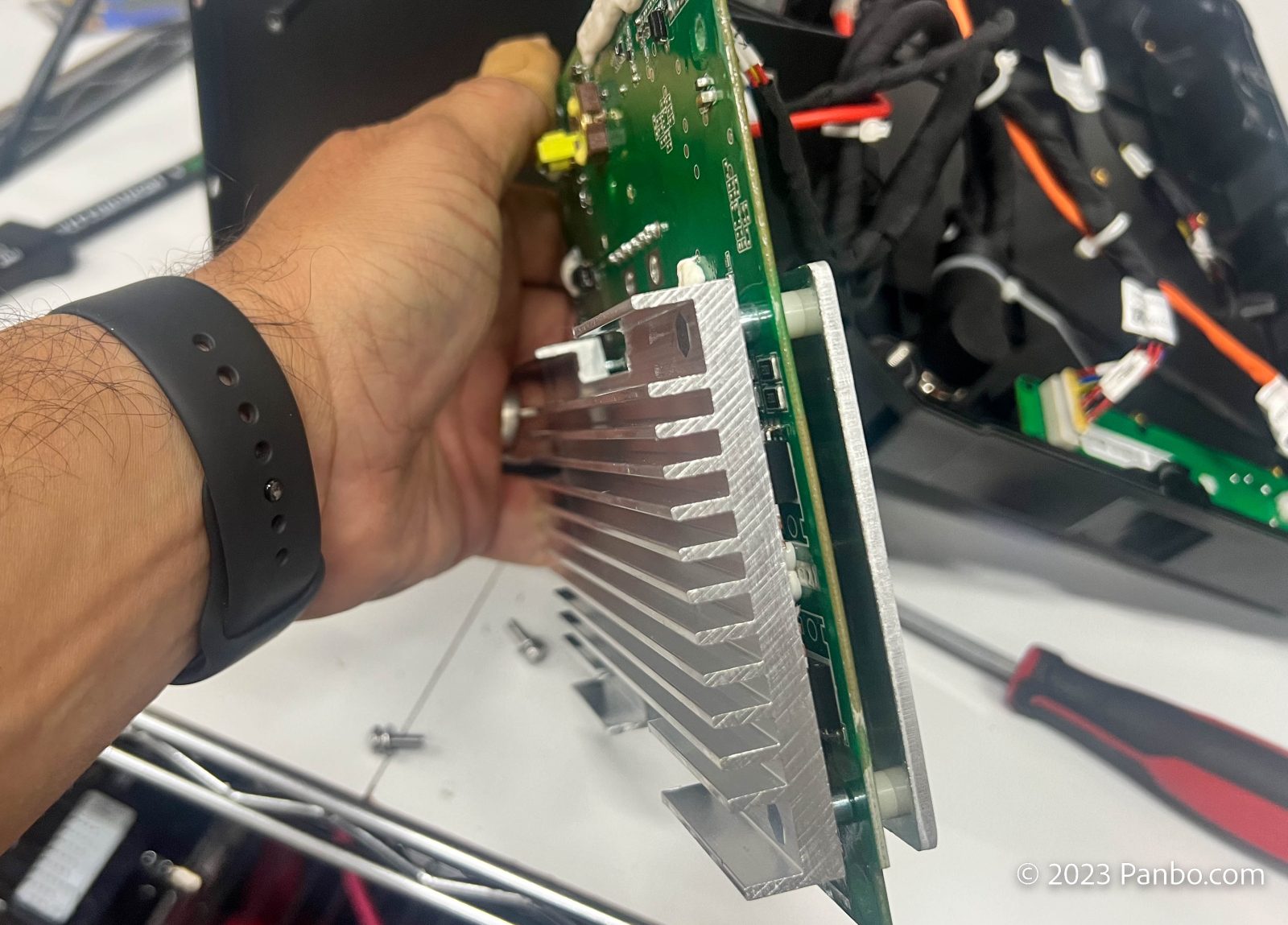
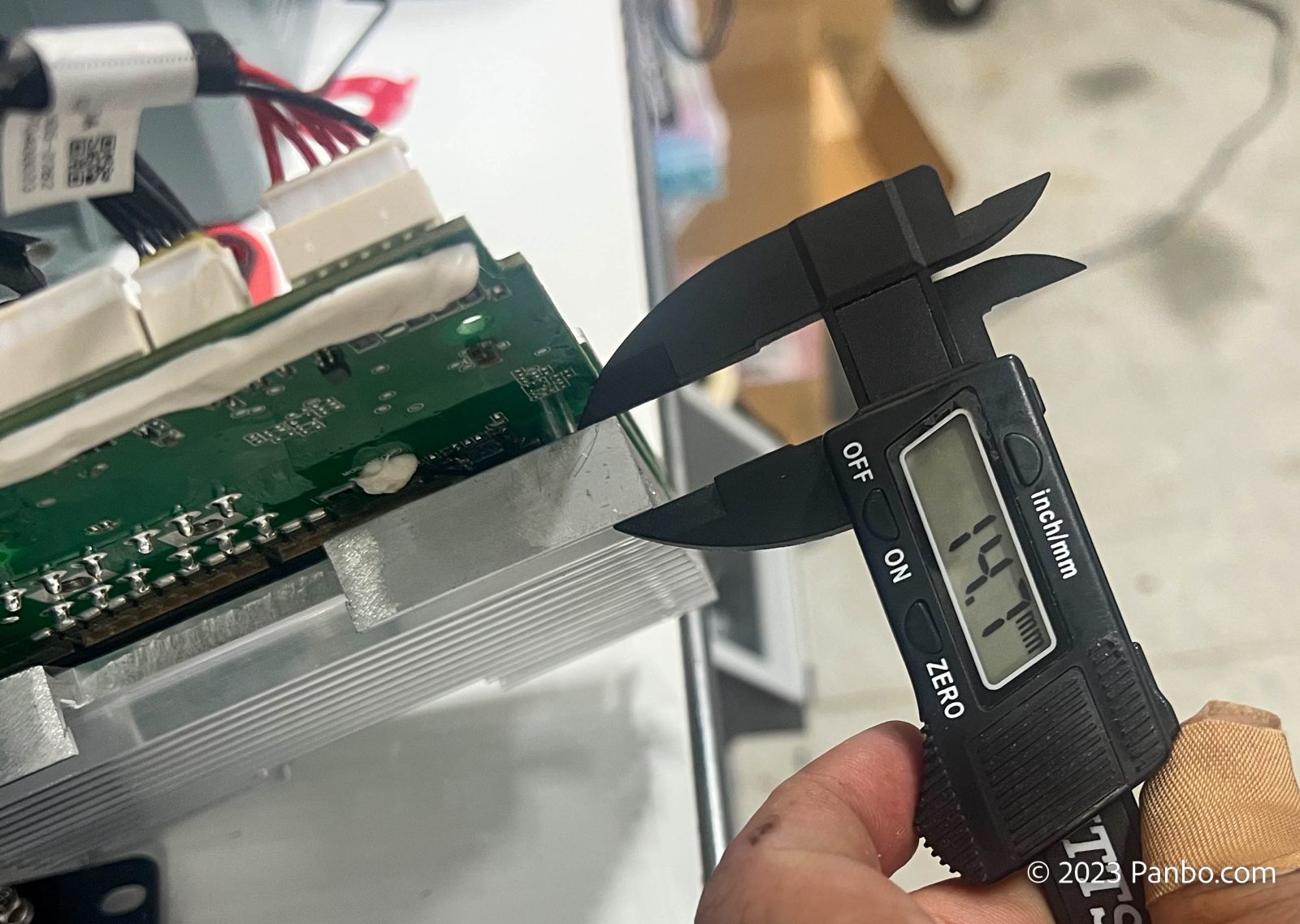
But, on the back of the BMS, a large, fluted heat sink provides significant cooling to the BMS’ 24 FETs. In my testing, I saw this heatsink get quite warm, but it seemed it was doing its job of wicking heat away from the FETs.
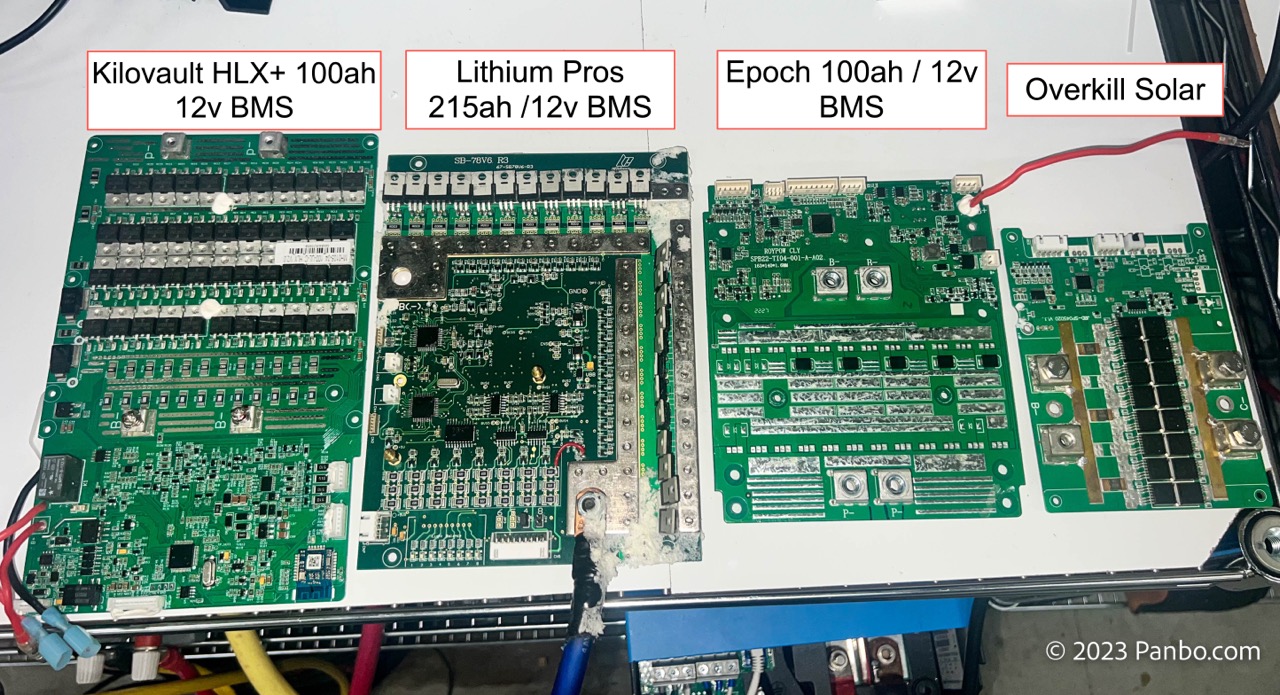

Let’s also look at the Epoch’s BMS compared to units from Kilovault, Lithium Pros, and Overkill Solar. At 120 amps continuous, the Epoch BMS handles 20 more amps than the others. The Epoch BMS appears similar in size and construction to the Lithium Pros and Kilovault. Like those two, the design of the BMS better dissipates heat than the JBD/Overkill Solar BMS.
Thermal results
At the time the thermal image above was taken, the battery was being discharged at over 150 amps. As you can see in the images above and below, the BMS was certainly working and that generated significant heat from the FETs.
The battery ratings support a continuous discharge of 120 amps and 200 amps for up to 30 seconds. I subjected the battery to a continuous discharge of roughly 160 amps. That’s pretty obviously over what the battery’s ratings and yet, the battery never shut down. I used a heat gun to get the temps over 200 degrees to trigger a shutdown. I suspect my potentially abusive testing may have shortened this battery’s life. But, with my testing complete, I performed a 20-hour run-down test again. That yielded a capacity of 108 amp hours. Still in excess of the 100 amp-hour rating Epoch advertises and above the rated capacity of the cells.
Final thoughts
These are some of the nicest drop-in batteries I’ve tested. I’ve gotten my hands on some high-quality batteries and these rival the best of them. A few small issues in the app should be addressed, but none proved problematic to the battery’s operation. A review of ABYC’s E-13 lithium standard shows that Epoch is extremely well-positioned to meet not only the current requirements but also the notes and recommendations. I’m really hoping Epoch will expand their range with higher capacity units and increase the physical density of the batteries. But, all that said, I can recommend these batteries without any hesitation.



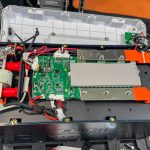









Epoch currently has the 100 Ahr for $449!
Smokin deal
Thanks for pointing this out. As Dave points out, Epoch has added a new, 100-amp-hour, 12-volt battery that’s currently available for $449. This battery looks like it has the same electrical specs as the unit I reviewed but appears not to be IP67 rated. Additionally, the more basic case doesn’t include the mounting feet of the IP67 batteries. But, at $149 cheaper, this could very well be a great battery for many applications.
-Ben S.
Amazing. I just put a 36 volt unit in my Golf cart and its been great. I have 6 on order for my Trawler now.
I’m about to do the same but some people are telling me that the amp draw is going to cut the BMS out. Have you had that experience?
Ben,
So glad you are bringing attention to Epoch. These are by far the best built, best value drop-in batteries being made. No short-cuts!!
-Rod Collins
MarineHowto.com
Hi Ben – Nice review – What is the charge rate on this BMS? Tom
Tom,
The battery is rated for 0.5C continuous charge or 50amp. I saw the BMS shut down charging when I exceeded 100 amps of charge current.
-Ben S.
Ben, does the Epoch CANbus implementation use some sort of data protocol that could be displayed on a boat fairly easily?
That’s a great question. So far, I haven’t found any information on their CANBus integration. I’ve asked Epoch themselves and they are investigating. My hunch is the CANBus capabilities were built into the BMS and they haven’t figured out how to use them yet. I suspect I’m not the only person after this information, so I’m hoping they will get something published on it soon.
-Ben S.
The $499 option would be great for the boat, but it appears to lack the Bluetooth option. It’s IP65 and mounting options match my existing FLA batteries.
Paul,
Good catch, I hadn’t seen that difference. That’s an interesting feature to have removed. The battery does still have a CANBus port. So, if more can be learned about the CANBus communication options, you may be able to get the information you need via that route.
-Ben S.
Also, can the CAN bus talk to an alternator regulator like the Wakespeed in order to turn off the alt in case of and HVC or LVC event? Most of the so called “drop in” batteries don’t and this can cause problems later on.
Ben, great write-up and excellent photos. The performance numbers alone are impressive – when combined with the build quality and price point, Epoch seems to be in a league of it’s own.
I’m starting to appreciate the the price premium of LiFePO4 batteries is not just a market-based number justified by their performance – there’s really a lot of complex design and manufacturing involved in creating this powerhouse. Really nicely done, Epoch.
Grant,
LiFePO4 batteries are fascinating to me. Initially, I wasn’t sure they were that big of a game changer. But, the more time I spend working with them, the more I’m convinced I was wrong. They’re a pain to install because of all the broader considerations of charging voltage, load-dumps, charge acceptance, and more. But, once installed, they’re just vastly superior to what we’ve been using.
As I came to better understand lead-acid’s behavior, I became more frustrated by the fundamentally fragile and fussy nature of the batteries. The more I understand about LiFePO4, the more I appreciate the characteristics of the batteries.
I’ve got a pretty good contrast going right now. I’ve just wrapped up testing on Epoch’s batteries, and now I’m moving right into testing a Li Time battery. At $3/amp-hour, it’s about as cheap of a battery as you will find. I’ve just done the tear-down and while it’s not anywhere as elegantly made as the Epoch, it’s still a fine battery. Plus, run-down tests show this battery too is over-achieving it’s rating. At $3/ah, you’re talking about $3.75 per usable amp hour, assuming 80-percent depth-of-discharge.
In March of 2021 I did some analysis on the cost of LiFePO4 versus the cost of lead acid (https://panbo.com/lithium-battery-math-better-than-you-may-think/). At the time, I could find a 100ah deep cycle lead-acid battery for $100 while a 100ah LiFePO4 battery was $900. Today, a 100ah flooded-lead-acid battery is roughly $125 and a the cheapest 100ah LiFePO4 battery is $300. That lead acid battery might make it to 300-500 cycles if you’re exceptionally kind to it. Every bit of testing I’m seeing says that LiFePO4 battery will make it to 2,000 cycles and may make it to as many as 5,000 cycles.
As you can see, I’m really bullish on the technology. My testing gives me far greater confidence in the safety of LiFePO4 than I’ve ever had in FLA. Yes, BMSes can decide that now is a good time for a shutdown event or they can fail, but I believe that can be easily mitigated with system designs that employ multiple batteries. I’ve logged about 30,000 miles in my RV with LiFePO4 and now have quite a few deployed. So far, not one has given me a bit of trouble.
-Ben S.
Thanks Ben. I’m definitely leaning more in the LiFePO4 direction, since pricing continues to become more competitive, and the technology matures. I would say that the biggest selling points for me is the almost 100% improvement over FLA in DOD capability, which reduces the size/weight consideration by a half as well, combined with no (watering) maintenance. And the .5C charge acceptance rate, compared to .15 – .2C rate for FLA, can make a big difference in real world cruising scenarios.
The total life cycles, on the other hand, seem almost meaningless – so much so that I often wonder why folks give them so much attention. If I live to be 100, and keep the same boat the whole time, I’d still never fully cycle my house batteries more than perhaps 400 times (10 times a season). So the cycle limit is never really a factor. I suppose if you live aboard with no shorepower or generator, then cycles become an almost a daily occurrence. But that would seem to be a very small minority of marine installations.
The FLA battery is going to need replaced after 6-7 years, no matter how well it’s maintained. If the LiFePO4 can outlast that in terms of years, not so much cycles, that’s of real value.
I haven’t owned a set of LiFePO4 batteries for 6-7 years yet. But, extrapolation of what I’m seeing combined with reports from trusted sources makes me believe you’re likely to be pleased by the calendar longevity of the batteries.
In regards to your thoughts about cycle life… I hear you and agree that most boaters won’t fully cycle their batteries very often. So, depending on your use case, you may or may not see value in cycle counts. I tended to cycle my batteries something between 50 and 100 times a year. Those cycles varied from 30% DoD to at least 50% DoD depending on the situation. On the Have Another Day, once I moved to LiFePO4, I loved that I could cycle to greater than 50% DoD without feeling like I was murdering something. I guess that meant part of the return for LiFePO4 was non-financial. It was peace of mind that I wasn’t abusing the batteries and hence setting myself up for a replacement.
-Ben S.
We just finished a two week electrical upgrade on our cat that includes installing 900ah of Kilovault batteries. I know it’s cliche to say lithium on a cruising boat is a game changer but we are simply blown away at what this system does.
I only wish we made the change years ago.
Last year, we upgraded our Sagres (an Ericson 27) to LiFePO4, and it’s been an absolute game changer. We now have 460Ah of usable house power (compared to 90Ah with our old FLAs), a 2kVA Victron inverter/charger, and all the other bells and whistles. Yeah, it wasn’t cheap, but we now never need to worry about electrical power any more as we explore the coast of British Columbia. The entire electrical system is integrated so the battery, inverter/charger, alternator, and solar controls all communicate and work appropriately with the battery. The battery is in full control of all charging. Because the system is fully integrated, load dumps aren’t a major concern. If the battery decides it does not want any more power (due to balance issues, or being full, or out of temperature spec) it just sets the battery current limit to 0A, and the charging sources move to just powering house loads.
For a BMS, we went with a REC ABMS, which is a contactor based BMS. If it does crap out on us in the wilderness, I can override it fairly easily. My main contactor is a BlueSea 7700 series solenoid, which can be manually overridden. If that happens, all the charging sources go into a limp mode, which will protect the battery.
We can also monitor it all remotely through Victron’s VRM system, so even when the boat is tied up at the dock, I can check on her every few days to make sure things are good. If something goes wrong, the VRM system automatically emails both myself and my co-owner, letting us know the problem, and gives us the time to get out to the boat.
Funny…i just did a review of th3 36 volt version. There is also another area that shows historical data that will work great to monitor charging over time and allow you to look back over the previous days or weeks. https://youtu.be/fLEwJadwuTc
What type of charger can be used with these batteries? Do I need to junk my FLA/ Gel / AGM inverter charger and install all new LiFePo capable charger? What about my dead simple Alternator with no special smarts that wants to run at 13.6V at all times? Can it be used with these batteries or do I need to retrofit that as well?
I have to admit that after looking at your IR images of the batteries, the idea that my batteries are going to be running at say 120F under more realistic conditions has me pretty nervous. When running for several hours on a cruise with the engine room hitting 90F or better in summer conditions, what does that mean for battery life with continuously elevated temps? Extended battery life is critical to pay back calculations when making a decision like this. Is there any information on whether these batteries will exceed the 5-6 year lifespan of my FLA by a factor of say 2X to payback the initial investment?
Lastly, in my previous life I designed electronics for Safety of Life reliability (called Level A for Avionics). All of our electronics required the simplest possible implementation at the lowest possible power dissipation levels, with the least possible parts count to achieve a required level of reliability and safety. Analysis of system failure modes was also critical and implied the simplest system block diagram is the safest and most reliable. I know this is not an aircraft but it’s also not a car – you can’t stop and get out if batteries fail in some unsafe manner. The massive number of BMS components running at elevated temperatures is a huge source of potential failure modes and implies reduced operating hours before failure. All FETs, capacitors, chips etc are rated for expected lifetime that is reduced as a function of increasing junction or ambient temperature (junction is the internal device 3 terminal connections of Gate Drain and Source in the case of FETs). So if these batteries operate at elevated temperatures most of their lives, I wonder if I can really expect 10-12 years of service life and in the back of my mind I worry about catastrophic failures.
David,
There’s not a simple answer to the ability to re-use an existing charger. If the charger can be programmed for in-range voltages through bulk, absorption, and float it may be usable. But to be usable, you also need to be able to disable temperature compensation, otherwise, you risk too high of voltage in colder conditions. A simple alternator can be usable with LiFeP04 batteries, but you need to look at the rating of the alternator and whether it’s likely to be destroyed by the higher charge acceptance of LiFePO4 batteries.
The best advice given about a conversion to LiFePO4 is that you need to look at it as a system upgrade, not just a battery upgrade. All portions of the charge system will need to be, at a minimum, verified.
There’s lots of information about longevity of LiFePO4 batteries. Most estimates are around 10x the cycle life of lead-acid batteries. Additionally, 10 years seems to be a very safe lifespan for the batteries. Rod Collins of MarineHowto.com often references his own 13+ year old DIY battery that continues to test at rated capacity after 2,200 cycles. That’s pretty compelling, though anecdotal, evidence of battery longevity.
Please understand that I didn’t put in the really boring images of the battery sitting at almost exactly environmental temperatures. It required a huge load to a single battery to get the temperatures moving at all. If the same load had been applied to a multi-battery bank, I don’t think there would have been much temperature rise at all.
-Ben S.
Why is “Li-Ion” molded on the casing when they are clearly not? This is not just a marketing thing. For firefighters it is probably quite relevant what type of Lithium batteries they are dealing with. Even so for future boat owners.
Timo,
Because LiFePo4 is Li-Ion… There are many Li-Ion chemistries, LiFePo4 just happens to be one of the safest.
OK, didn’t know that. Still, a clear / better indication of the type of battery is perhaps even so a good idea.
we have been working recently with Roypow here in australia “epoch seems US only and why not go straight to the source” the batteries “whilst slightly heavier than other lithium offerings” seems rather good! a factory represenitive was out here recently and was very keen to hear how far they are progressing with 48volt as well.
there looks to be a few other battery monitoring systems coming soon. and 200AH 12v/24v batteries on the way.
but so far so good 😀
Ben…question: when you induced some of the faults, did the monitor give an audible signal and flash?
I don’t recall having heard any audible faults at all. I do remember the SOC indicator flashing during faults.
-Ben S.
There are no manufacturers of Lithium cells of that sort made in the USA or else apart from China. This may explain the affordable price in US dollars.
Your sales price is unique and I hope you sell many of them to catch-up on the cost of certification. In fact is there any international certification to UL and UN standards.
Lab test standards are necessary to guarantee safety and good business practice. Selling a price may be attractive but selling a safe product should be essential.
As you should know, Lithium batteries are subject to be unsafe once they come close to end of life. Safety is an important issue and you should also be able to supply instructions for recycling.
I thoroughly agree that all batteries should be recyclable if not repairable. But the technology is getting there and most of the LiFePO4 batteries we’re using on boats look like they’ll last quite a long time. As for LiFePO4 batteries being “unsafe once they come close to end of life,” I don’t see evidence of that. Please explain.
Ben, Great report!
Nice well built battery. While no longer owning my boat Carolyn Ann it’s custom etc. LFPO4 bank system is still good after 11 years as of last report.
I still wait for drop in’s to incorporate an alert audibly and or light as well as a slight delay function prior to invoking an LVC or HVC cut-off of the bank. Ours was both audible and warning light at the helm and had a 2 minute delay. We had agm group 31s for start batteries these also acted as a buffer 12volt supply if bank shutdown from LVC or HVC. Good if underway and needing Navigation operational. We ignored the charging difference between the two chemistries which was biased to the LFP04 chemistry. The agms didn’t seem to mind and lasted 8 years.
So, Joseph, did you typically operate with your AGM and LiFePO4 banks in parallel? I understand that some think that a big no-no, but I’ve been researching an interesting German company that has designed LiFePO4 batteries to do that, resulting in what seem like several nice features: https://www.bos-ag.com/
Would like to see a listing of FAULT or ERROR Codes that these batteries Generate off the BMS!
I just purchased the Epoch 50ah battery to replace my FLA Group 27 90ah house battery. One thing to be cognizant of, specifically with the Epoch batteries, is that the physical size is surprisingly large. When I hear the lithiums advertised as “drop in” replacements, my brain takes that literally. As in, able to fit in, say, a standard battery box (yes, I know the Epoch has its own mounting system).
So shame on me for not looking at the actual dimensions of the Epoch. I would have never expected a 50ah, 22lb lithium battery to be physically larger than a 90ah 55lb group 27 battery. But here I am with a gorgeous Epoch battery that now doesn’t fit where it needs to go. It is a good bit taller and wider than my FLA.
It’s a frustration entirely of my own making, but I do think “drop in” can be misleading in this particular instance.
Darn! The lack of Victron compatibility is a deal killer for me. Sounds like a fantastic battery though. Will keep my eye on them and if they can solve this, i would upgrade my entire battery bank in an instant.
They just came out with several more models aimed at us. One is a 300ah batterry with comms and Victron compatable for $1199
wow! Thanks. i will have to check this out.
As of today no epoch battery is compatable with victron .
I cannot get a victron tech to install my epoch batteries and am on my own
While you may be having a difficult time finding a tech familiar with a relatively new battery, it’s certainly not accurate to say the batteries aren’t compatible. I have it working on my test bench with less than a minute spent plugging it in. Others on this thread also have it working.
Sorry you’re having trouble finding someone to help with the install. Where are you located?
-Ben S.
Not sure why you need a Victron technician to install your Epoch battery. A good ABYC certified electrician if he he has kept up with the changing technology should be capable of the installation. You may have to check around but should find someone.
I have mine working great. This may help.
https://youtu.be/pIXSKpi-TRo?si=6MW1LSOn4haYkasp
Anonymous beat me to the punch. I’ve sent an inquiry to Epoch about these batteries to see if I can get my hands on some. The construction looks different than the batteries I’ve reviewed so far, but if they’re built as well as the 100 ah batteries, these would be an extremely interesting option.
-Ben S.
I couldn’t find them on the website – Can someone provide a link?
Sure, I found them under the 12-volt section: https://www.epochbatteries.com/products/12v-300ah-v2-heated-bluetooth-lifepo4-battery-epoch-essentials
-Ben S.
Keep us posted if you manage to do this. It would be very interesting to see if they communicate with no glitches. This is a great price for that many Ah in a well constructed Lithium. Very tempted to buy one now….
Apologies for posting anonymous. Can seem to figure out my log in. If it doesnt show up again my name is Allen Jones and I posted earlier in this thread. I plan to purchase 2 of these 300 AH units. I have also head there will be 460AH units coming soon.
Anyone know if these are roypow made batteries?
I went ahead and ordered the one in the link. Looking forward to testing it out on my sailboat. It doesnt say anything about its IP rating but it will be very well protected.
Thanks! I looked there Friday and didn’t see them, got it now.
Ben E.,
Sorry for the crazy delay answering your question RE running the agms in parallel with our LFP bank which we did thru an acr without issues. Charlie Johnson (JTB Marine in St Pete [email protected]) designed and installed the systems. Charlie is on the AYBC subcommittee for inverters and is now linked up with Victron for training in the US on their systems. Give him a shout if you have any questions. RC was also consulted as well as others. This effort was really cutting edge at that time 12 years ago with much consulting with dyi electric vehicle conversions.
Looking at running away from lead acid for my 5th wheel. I want been obsessing.over Battle Born for a while now. But have not pulled the trigger due to other projects. Your review is compelling. However, my question is looking at the company being US based. Where (country) is the battery’s manufactured? And I asking for two reasons. I have a few elec components that are foreign manufactured but dealer sales in the US. They are great but if you have an issue with a unit it is harder then he’ll to get someone from customer service to Warranty the product. Or even talk to someone about an issue.
Companies like Battleborn import the components from China and assemble, test, pack and ship from the US. Lithionics Imports the cells from China and does the rest here. There are no LFP factories outside of China yet but there is a US factory in the works. So far Battleborn has a great reputation for customer service as does Lithionics. So far Epoch has been very responsive to both myself and our customers.. As long as there is a good US company behind the brand you are far better off than buying direct from China brands like Ampertime, Chins, Powerqueen etc.. I personally just dealt with a defective Power Queen battery (BTW same company as Ampere-Time /Li-Time)and the run around was a PITA…
https://marinehowto.com/critical-lifepo4-data/
Why not just call them to discuss? They have a very comprehensive website, including company history, and an 800 number. I’m sure they’d be happy to answer all your questions!
https://www.epochbatteries.com/pages/about-us
Any luck getting customer service to answer questions? I’ve tried for days via email and their facebook. Tried the phone and no answer. No replies back at all to basic questions like wanting to see their manual for the new essentials batteries. Makes me feel like after sale support would be basically zero. It sucks when you really like a product and want to spend thousands per year with a company only to have them brush you off.
Chris, not sure why you had an issue – I just called them (1710 EDT) and they answered on the first ring. I told the fellow about your post, and he found it strange – said they take pride in responding to all calls and emails promptly, which has also been my experience.
Ben
Have you got chance to take a closer look at the new Epoch 300 Ahr battery? Getting very close to having to replace my 13 year old AGM bank and very interested in the Epoch.
Hey. I finally heard back from Epoch about these. The drawback right now is they actually have no manual or recommended charge settings yet. Even though they are actively selling the battery. Very odd. Since the warranty would require the customer to use the recommended charge settings. So i’m gonna wait a bit for that info to come out.
It’s strange that they don’t really list in depth charging settings for any of their batteries. Equipment can vary as far as “default” lithium settings go. I’d much prefer have the company recommend specific voltages for their cells.
Chris, I’m not sure that’s accurate or fair. There are quite a few specs listed for the 12v 300ah Essential model listed, right on the webpage, including Charge voltage range, max charge voltage, max charge and discharge amperage, etc. As a new product, I assume a PDF manual will be forthcoming shortly. Your comment that “they don’t really list in depth charging settings for any of their batteries” is just not correct. For example, the battery reviewed in this blog post has a downloadable 23-page Product sheet, and a 16-page illustrated owners manual, with every possible detail you can imagine.
It’s obvious to me that Epoch is committed to producing quality products with full documentation and support.
even the manuals they have for a few batteries do not list full recommended charging parameters. Just ranges for bulk charge voltage. As confirmed to me by Kevin(an actual employee of the company) last night. No further details such as Peukert exponent etc…. Now you can simply go with parameters that work for most lithium batteries but it seems to me this is a big gap in the literature that can lead to an easy way to decline warranty claims. No other battery company I have ever seen fails to list a specific bulk charge voltage for their cells.
Victron equipment users also need absorption and float voltages listed since on most of their stuff you can not turn these off completely. Kevin recommends matching the bulk charge voltage for both of absorption and float. Which obviously makes sense for absorption but Ive never seen that for float voltage before on other lithium batteries. In one of their manuals they also recommend parallel setups take the positive and negative load of the string from the same battery. Another thing I have never seen recommended by other companies.
Its clear you are kind of a fanatic about the company. Do you work for them? Not once in my posts did I question their quality. It’s obviously high end. And I will likely still be spending a lot of money with them. But with slight hesitancy because their customer service has not been good at all aside from contacting Kevin directly.
I can tell you from experience these chinese battery companies can appear amazing as far as quality and value go…only to end up being quite a painful experience in the end. So vetting them is important. I’m not just buying one battery for a boat and calling it good for 10 years. I’m a business buying many batteries that will be in clients vehicles for years. Im sorry if properly vetting a new company seems like a step too far for you.
Chris – no, I don’t work for Epoch, and I wouldn’t say I’m a fanatic. I follow emerging marine technology and have a lot of respect for experts who have reviewed their batteries in much more detail than I’m able to. The consensus seems to be that they’re near very top of the industry in product quality. It seems unlikely that a company this devoted to designing and building a top quality battery would end up being a scam operation with no support or warranty. There are plenty of bad actors selling questionable products online. Nothing that I’ve seen would indicate that Epoch is one of them.
Of course anyone entering a B2B relationship should do due diligence, and no one can predict where Epoch or anyone else will be in 10 years. But they’re not exactly a “new” company, according to their About Us webpage. That said, it’s obviously not like dealing with Interstate or East Penn, either. I’m only saying that based on everything I’ve seen and read, and conversations with their employees, I would have no reservations dealing with them as an end user.
Best,
With the issuance of ABYC E-13 recently and the inclusion of specific requirements for manufacturers’ literature, it would seem that Epoch should have a strong incentive to meet these requirements before releasing new batteries as “marine”.
Ben, I notice Epoch has listed 12V 300 amp-hr batteries that will ship soon. One version has VE bus comms, though I don’t know what they communicate to the Victron equipment. Very impressive price point. Would you consider a review of those newer batteries?
By the way, nice article.
Definitely interested in getting testing done on the larger, BMS connected batteries. I’ve been in conversations with Epoch and they expect to have units in the U.S. in quantity in a little over a month. I hope to get my hands on some batteries then.
-Ben S.
Would really love to see a tear down. I got mine a few weeks ago (still not hooked up) but im too chicken to crack it open. The build quality is very high quality. There is a newer video on you-tube of a guy that hooked one up in his camper and he said the Victron coms went very well and was seamless.
I think a lot of us are interested in this battery – but I’m not sure we’d learn very much new from another “tear-down”. Is there any reason to suspect the build quality would be any different from the exceptional level found in Ben’s original article?
I’m much more interested in the Victron communications aspect, and how well that actually integrates to control the BMS, alternator output, etc…
I agree. I watch so many battery tear down videos, to me the term ‘teardown’ generally includes a peak inside and all the stress testing that comes with a new battery. For example, im quite curious to find out what type of seal is around the lid (if any) and if any of the external connection ports are potted inside the battery as its not IP rated.
Hopefully in the next few weeks ill have the time to upgrade my distribution panel and wiring so i can start the install of mine and test the Victron comms personally. I do like to see the inside just from a curiosity perspective if nothing else. I expect it will be exceptional based on the batteries capabilities on paper at least.
Hi all. Just got 2 of the new 460ah models. Of course, my boat is 12 hours away and have no victron stuff hear. But has a whole victron harness to connect.
Will let you all know how it goes.
Ray
Ben,
I read some LFP batteries completely disconnect themselves (no power out) if the charging voltage is too high. In your testing did the BMS just stop the charging or did the battery do a complete disconnect (no power out).
I do not understand why most BMS would shut the whole battery down rather then just shut down the fets that charge the battery. Is it possible to save costs, they use one set of fets for charge and discharge and shut them all down on overvoltage? Some boat alternators charge around 14.7 volts and concerned this may cause the battery to shut down completely (no power out and blown alternator diodes).
EVE does NOT own Epoch.
That is totally false and invented by 18650 Battery store management or owner.
The 18650store owns Epoch.